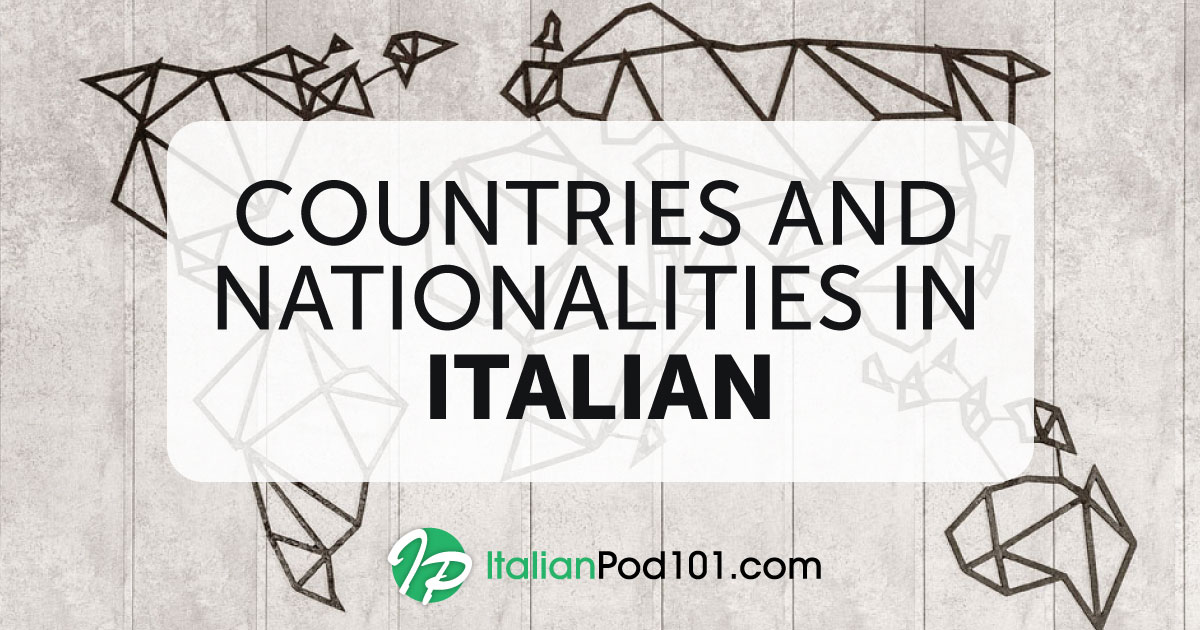
Proverbs are pearls of wisdom, sometimes coined by famous individuals but more often of anonymous origin. Some proverbs go back to the beginning of humanity itself, and although they sound a bit old sometimes, they always have a practical application in everyday life and can help us deal with complicated situations.
In general, proverbs tend to transmit popular wisdom in a very concrete way. They often stand out for their irony, their colorful comparisons, and their funny tones and metaphors.
Italian proverbs are an important part of the language, because…
- …Italians use them often in conversations.
- …they belong to a shared body of knowledge.
- …they typically denote specific cultural traits of the country.
That last point is especially important, because each culture has its own set of proverbs and idioms. They reflect a particular sense of wisdom, in harmony with the history of each country. Many of these are universal, but there are equally well-known local variations.
In this guide from ItalianPod101.com, you’ll learn about some of the most common Italian proverbs, what they mean, and how to use them.

Proverbs = traditional popular culture.
 Table of Contents
Table of Contents
- Proverbs About Time
- Proverbs About Food
- Proverbs with Animals
- Proverbs About Love and Family
- Proverbs About Life, Wisdom, and All the Rest…
- Conclusion
1. Proverbs About Time
There are a great number of proverbs about time, maybe because our wise ancestors knew how important it is—and how easily we forget about it or even waste it.
#1
| Italian | Il mattino ha l’oro in bocca. |
| Literally | “The morning has gold in its mouth.” |
| Equivalent | The early bird catches the worm. |
| This is the perfect proverb to begin our guide, since it deals with getting the right start. According to this proverb, if you get up early, you’ll get the most out of your day. This proverb also praises the value of acting immediately, and presents a concept well-known since ancient times and in many different cultures. Another version of the same proverb is: Chi tardi arriva, male alloggia. (“Who arrives late, settles badly.”) And you? What part of the day do you prefer? | |
#2
| Italian | Chi dorme non piglia pesci. |
| Literally | “Who sleeps does not catch fish.” |
| Equivalent | Don’t love sleep, or you will become poor; open your eyes, and you’ll have enough to eat. |
| This well-known Italian proverb of ancient origin is used to warn those lazy ones among us that without work and commitment, it’s impossible to get what you want or need. The proverb is therefore a real exhortation to get busy because nothing is achieved without effort. | |
#3
| Italian | Meglio un uovo oggi che una gallina domani. |
| Equivalent | “Better an egg today than a hen tomorrow.” |
| This Italian proverb seems to express that it’s more convenient to settle for the little certainties of today than to risk losing them. In fact, it could have a double interpretation, which is a common characteristic of proverbs. Another meaning could be that of another common proverb: Chi non risica non rosica. (“Who does not take risks doesn’t eat.”) Both talk about the behavior of prudent people, as well as the behavior of those who are willing to risk a little. As Aristotle used to say… “Virtue lies in the middle, in the balance of the two opposites.” | |
#4
| Italian | La gatta frettolosa fece i gattini ciechi. |
| Literally | “The hasty cat made the blind kittens.” |
| Equivalent | Haste makes waste. |
| This proverb emphasizes that everything should be done at the right time and in the best possible way. Haste is always a bad advisor, and even if it gives you the impression of being very productive, it can eventually create some unpleasant situations to solve. So, beware of multitasking and hyperactivity…! | |
#5
| Italian | Se sono rose, fioriranno. |
| Literally | “If they are roses, they will bloom.” |
| Equivalent | Time will tell. |
| This old proverb has a second part that’s usually omitted… “if they are thorns, they will sting.” But in any case, the meaning is clear: Keep working on a job or a project with faith, because only at the end will you see the results. And if you want to keep optimistic about it, you can rely on yet another proverb about time: ll tempo è galantuomo. (“Time is a gentleman.”) It means that in the end, time will solve every problem, even if you can’t see it at the moment. | |
#6
| Italian | Il buongiorno si vede dal mattino. |
| Literally | “Good morning starts in the morning.” |
| Equivalent | A good beginning makes a good ending. |
| This proverb reminds us of something we already know: If a day or endeavor has a good start, it’s likely to be a success. If it starts well, it will probably end well. This is also the bottom line of another very common Italian proverb, stating: Chi ben comincia è a metà dell’opera. (“Well begun is half done.”) Both proverbs stress the importance of starting con il piede giusto (“with the right foot”). | |
#7
| Italian | Meglio tardi che mai. |
| Equivalent | Better late than never. |
| This is the perfect proverb for the typical Italian… While it may be an oversimplification, it’s partly true that Italians tend to be late. Not all of them, obviously, but arriving a little late to an appointment (especially among friends and family) is accepted—and even almost expected—in Italy. So, if you’ve been waiting on someone or something for some time, you can use this proverb to express your disappointment with a little irony. It’s also used in reference to people who finally change a bad behavior or have finally come to understand something: Finalmente hai lasciato il fidanzato…meglio tardi che mai! (“You finally left your boyfriend…better late than never!”) | |
#8
| Italian | Finché c’è vita, c’è speranza. |
| Equivalent | Where there’s life, there’s hope. |
| This proverb comes from a quote by Cicero from more than 2000 years ago. It encourages us not to despair, even in difficult situations. As long as we’re alive, we can still make our dreams come true. How wise and optimistic is that? Another way of saying it is: La speranza è l’ultima a morire. (“Hope is the last to die.”) | |

A good morning starts in the morning.
2. Proverbs About Food
Italians love to eat. They eat all the time, and when they’re not eating, they’re talking about food! It’s only natural that there are so many popular Italian proverbs about food and wine.
#9
| Italian | Come il cacio sui maccheroni. |
| Literally | “Like cheese on macaroni.” |
| Equivalent | To be just right for the job. |
| Cacio—a mixed cheese made of sheep’s and cow’s milk—is the perfect combination for macaroni, because its strong flavor completes it. So, you can use this proverb when describing something that makes a situation just perfect. This proverb must date back to the origin of the short and pierced pasta called macaroni, in the early Middle Ages in Sicily. Even today, this combination of pasta and cacio is present in the well-known Roman cuisine dish called “cacio e pepe.” There’s another Italian saying that means the opposite: come i cavoli a merenda (“like cabbage for snacks”). This refers to a combination that just doesn’t work. | |
#10
| Italian | Buon vino fa buon sangue. |
| Literally | “Good wine makes good blood.” |
| Equivalent | An apple a day keeps the doctor away. |
| Nothing goes better with a pasta dish than a good red wine…but in this proverb, we also find the ancient wisdom that a little (especially red) wine every day makes your whole spirit better. If wine isn’t your favorite drink, check out our vocabulary list of 20 Drinks to Quench Your Thirst and learn how to say your favorites! | |
#11
| Italian | O mangiar questa minestra o saltar questa finestra. |
| Literally | “Either eat this soup or jump out of this window.” |
| Equivalent | Take it or leave it. |
| Whether it’s something we don’t like on our dinner plate or any other unpleasant situation, we’re often presented with things that we have to accept out of necessity, because there’s no alternative. Interestingly, the Italian term minestra today simply means “soup,” but in Ancient Rome, it referred to any food served at the table. This is because the minister was the person who served food during meals (from which we get the verb “to administer”). | |
#12
| Italian | Non tutte le ciambelle riescono col buco. |
| Literally | “Not all doughnuts come out with a hole.” |
| Equivalent | You can’t win them all. |
| Even though this proverb talks about the Italian doughnut ciambella, it’s not really about food. Rather, it’s about the fact that not everything turns out as planned. It also encourages us to be ready for surprises! | |
#13
| Italian | Avere le mani in pasta. |
| Literally | “Having your hands in the dough.” |
| Equivalent | To have a finger in the pie. |
| This expression refers to being involved in a situation or project (especially a dubious one), either financially or for personal interests. It has a negative meaning and is normally used to refer to “dirty” business. It originates from the old times, when several people used to work together with sticky dough while manually making pasta and bread. | |

Not all doughnuts come out with a hole.
3. Proverbs with Animals
Why are there so many proverbs with animals? Since the oldest times, animals have helped people, made great companions, and provided food and warmth. For these reasons, it makes sense that they occupy a special place in the long list of Italian proverbs.
#14
| Italian | Cane che abbaia non morde. |
| Literally | “Dog barking does not bite.” |
| Equivalent | His bark is worse than his bite. |
| We’ve all met a grumpy person who yells and maybe even threatens us—but who, in the end, is totally harmless. Just like the dog that protects its home or owner by making lots of noise! | |
#15
| Italian | Il lupo perde il pelo ma non il vizio. |
| Literally | “The wolf sheds its hair but not the vice.” |
| Equivalent | A leopard cannot change its spots. |
| It’s very difficult to get rid of bad habits, right? That’s exactly what this old proverb means. In its original Latin version, it talked about a fox rather than a wolf, but the concept remains: a person can work hard to make changes in their life, but still struggle to overcome certain habits. Mario ha di nuovo cominciato a bere… il lupo perde il pelo ma non il vizio! (“Mario has started drinking again…a leopard cannot change its spots!”) | |
#16
| Italian | Quando il gatto non c’è, i topi ballano. |
| Equivalent | When the cat’s away, the mice will play. |
| There’s really no need to explain this proverb, which is common in many different cultures. We all remember when we were kids and our parents were away, right? | |
#17
| Italian | A caval donato non si guarda in bocca. |
| Equivalent | Look not a gift horse in the mouth. |
| This proverb has to do with good manners and graciousness: If you receive a gift, do not make a fuss about its value. It comes from not-so-ancient times when, before buying a horse, people would look into the animal’s mouth to determine its age and its health condition from the teeth. But remember not to do that if the horse was a gift, okay? | |

Gift or no gift…he doesn’t want you to look inside his mouth!
4. Proverbs About Love and Family
Because family and relationships are such fundamental aspects of the Italian lifestyle, there’s no shortage of love and family proverbs in Italian. Here are a few of the most common ones.
#18
| Italian | I panni sporchi si lavano in famiglia. |
| Literally | “Dirty clothes are washed within the family.” |
| Equivalent | Do not wash your dirty linen in public. |
| Dirty clothes, thanks to this popular proverb, have become synonymous with delicate and private matters. It’s better to solve delicate matters inside the circle of those who are directly concerned. Only those who are close, like members of the same family, can understand the facts and situations that those on the outside may misinterpret. | |
#19
| Italian | Moglie e buoi dei paesi tuoi. |
| Literally | “Wives and oxen of your country.” |
| This is a really dated proverb—way before globalization, Erasmus, and all the traveling we do today. It basically suggests that, like in agriculture, it’s better to stick to local “breed” in relationships and not marry (or breed) foreigners. Of course, it’s painfully politically incorrect today, especially because it only refers to mogli (“wives”) and it compares them to animals…but oh well, you got the point. After all, it’s just saying that cultural differences in a relationship will come back to haunt you in the long run! | |
#20
| Italian | Chi si assomiglia si piglia. |
| Literally | “Who looks alike chooses each other.” |
| Equivalent | Birds of a feather flock together. |
| People tend to relate to others who have similar personalities, lifestyles, and tastes as they do. For this reason, we find it easier to establish relationships with people who are similar to us. Another related proverb says: Dimmi con chi vai e ti dirò chi sei. (“Tell me who you go with and I’ll tell you who you are.”) | |
#21
| Italian | Tra moglie e marito non ci mettere il dito. |
| Literally | “Between wife and husband don’t put a finger.” |
| Equivalent | Don’t go between the tree and the bark. |
| You should not get involved in family affairs that are not your own, because the problems of the couple are so intimate that they can be judged only by the husband and wife. In other words… Fatti gli affari tuoi! (“Mind your own business!”) | |
#22
| Italian | La mamma dei cretini è sempre incinta. |
| Literally | “The mother of fools is always pregnant.” |
| Equivalent | There’s one born every minute. |
| There are many versions of this very old and wise proverb: La madre dei cretini (“fools”) è sempre incinta. La madre degli idioti (“idiots”) è sempre incinta. La mamma degli stupidi (“stupid people”) è sempre incinta. La mamma degli imbecilli (“imbeciles”) è sempre incinta. So, you can change the word but the concept is the same: There will always be idiots around to make things difficult. | |
#23
| Italian | Volere la botte piena e la moglie ubriaca. |
| Literally | “Wanting a full wine barrel and a drunk wife.” |
| Equivalent | Have your cake and eat it too. |
| Here’s another example of a proverb that’s not very kind to Italian women…but its metaphorical meaning is clear: You cannot have everything in life! Vuoi dimagrire continuando a mangiare di tutto? Non puoi avere la botte piena e la moglie ubriaca! (“Do you want to lose weight while continuing to eat everything? You can’t have your cake and eat it too!”) | |
5. Proverbs About Life, Wisdom, and All the Rest…

Why is the neighbor’s grass always nicer???
We could all use a little guidance now and then, which is where these Italian proverbs about life and all of its trappings come in!
#24
| Italian | Occhio non vede, cuore non duole. |
| Literally | “Eye does not see, heart does not hurt.” |
| Equivalent | Out of sight, out of mind. |
| Ignorance can be a blessing and it sometimes spares us a lot of suffering. Another popular way of saying this is: Beata ignoranza! (“Blissful ignorance!”) | |
#25
| Italian | Chi troppo vuole nulla stringe. |
| Literally | “Those who want too much obtain nothing.” |
| Equivalent | Grasp all, lose all. |
| Don’t be greedy! This proverb ultimately invites us to not do/want too many things at the same time, because none of those things will be done well in the end. | |
#26
| Italian | A buon intenditor, poche parole. |
| Literally | “To the good connoisseur, a few words.” |
| Equivalent | A word to the wise (is sufficient). |
| This proverb indicates that if you’re intelligent and aware of things, you don’t need many explanations in order to understand a concept. A few words should be enough. | |
#27
| Italian | L’erba del vicino è sempre più verde. |
| Literally | “The neighbor’s grass is always greener.” |
| Equivalent | The grass is always greener on the other side. |
| Envy is one of the most defective traits we can have, but it’s unfortunately a pretty common trait in our society. Often, as this proverb suggests, we prefer to look at the possessions or success of those around us, often thinking they’re better than us. | |
#28
| Italian | Ride bene chi ride ultimo. |
| Equivalent | Laughs best who laughs last. |
| This proverb highlights how one should not celebrate before the end of a situation, even if things seem to be going in the right direction. And this is not only out of superstition! We all know that everything can change at the very last minute. | |
#29
| Italian | Fra i due litiganti il terzo gode. |
| Literally | “Between the two litigants the third enjoys.” |
| This proverb comes from the title of an Italian comedy of errors from the end of the eighteenth century. It means that sometimes, if two people fight about something, a third person might benefit in the end by taking advantage of the distraction and weakness of the two busy fighting. So, don’t make war, please! | |
#30
| Italian | Non è tutto oro quello che luccica. |
| Equivalent | All that glitters is not gold. |
| This metaphorical phrase warns about things, behaviors, or situations that appear fantastic from the outside—but which are far worse when you take a closer look! Another proverb that warns us not to judge by appearances is: L’abito non fa il monaco. (“The dress does not make the priest.”) | |

Life is made of stairs…
#31
| Italian | Il mondo è fatto a scale, c’è chi scende, e c’è chi sale. |
| Literally | “The world is made of stairs, some go down, and some go up.” |
| Equivalent | Every dog has his day. |
| Life, as luck, comes and goes. You never know what direction life will take. | |
#32
| Italian | Chi fa da sé, fa per tre. |
| Literally | “He who works by himself does the work of three (people).” |
| Equivalent | If you want something done right, do it yourself. |
| It’s true that often, in order to do a good job, you have to do it yourself. But, ironically, you could also say the opposite using another motto: L’unione fa la forza (“Unity is strength”). So, who do you think is right? | |
#33
| Italian | Tra il dire e il fare c’è di mezzo il mare. |
| Literally | “An ocean lies between what is said and what is done.” |
| Equivalent | Actions speak louder than words. |
| Talking is easy, but it’s much more difficult to actually do things. This proverb refers to people who have a tendency to speak a lot and make promises they don’t keep. | |
#34
| Italian | A mali estremi, estremi rimedi. |
| Equivalent | Desperate times call for desperate measures. |
| Sometimes a drastic action is called for—and justified—when you find yourself in a particularly difficult situation. | |
#35
| Italian | Sbagliando s’impara. |
| Literally | “Learning by mistakes.” |
| Equivalent | Practice makes perfect. |
| Don’t worry about making mistakes, as they are life experiences that we can learn from. And if you’re learning Italian, you can be certain that making a few mistakes is paving the road to greater skills. And practice—with ItalianPod101.com—definitely makes perfect! | |
6. Conclusion
In this guide, you’ve learned the 35 most common Italian proverbs. Do you know any others? Make sure to share them with our community in the comments below!
And keep up the good work with your Italian studies! We encourage you to take advantage of all the free resources, vocabulary lists, and video and audio podcasts on ItalianPod101.com to boost your studies and keep learning fun!
Make sure you also check out our Premium PLUS service, MyTeacher, to get personal one-on-one coaching with your own private teacher. He or she will use assignments, personalized exercises, and recorded audio samples to help you improve your Italian like never before!

10 Places to Visit in Rome, the Eternal City

Tutte le strade portano a Roma. (“All roads take you to Rome.”)
If you plan to visit Italy, you might as well start in the nation’s political and cultural capital. Another popular saying—Roma, città eterna (“Rome, the eternal city”)—sums up its unique historical importance and beauty. Rome is a multilayer city with immense artistic treasures and historical architectures that will make you dream of walking through the Ancient Roman Empire, the Baroque and Renaissance periods, and everything in-between.
Before you plan a visit to Rome, though, you’ll have to do your research. And that’s where we come in. In this article, you’ll learn what to expect and where to go for the best experience!
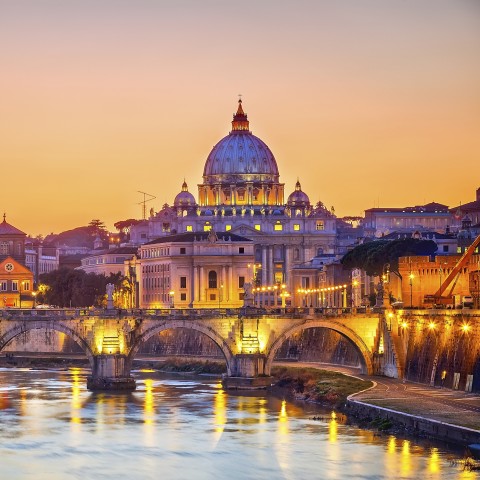
Rome, Eternal City

Table of Contents
- Before You Go
- Must-See Places for a 1-3 Day Trip
- Survival Italian Phrases for Travelers
- When in Rome… (Common Slang Expressions Used in Rome)
- Conclusion
Before You Go
The history of Rome, the one that everybody knows, starts with a bang! At one time, Rome was on top of the known world. At its peak, the Roman Empire spread from North Africa to England, and from Portugal to the Balkans, and lasted around five centuries.
In Latin, you would say: Roma caput mundi. (“Rome top of the world.”)
The wonderful thing is that you can still get a pretty good feel of Rome’s grandeur just from walking by the imperial ruins. But even with its size and majestic past, Rome is still a very easy-going city. A nice place to take a walk, yet full of mysteries and surprises.
As the capital city of Italy, Rome hosts all of the Italian government organizations such as the Parlamento (“Parliament”) and the Presidenza della Repubblica (“President Headquarters”). Also, the headquarters of Italy’s many political parties are here. So if you see a lot of very serious people, dressed mostly in blue and going around with an escort and many newspapers under their arms, you can guess who they are. In Italy, these locations are often referred to using the name of the building, so be aware of these terms:
- il Quirinale: where the President is
- Montecitorio: the Chamber of the Deputies
- Palazzo Chigi: the house of the Prime Minister
- Palazzo Madama: where the Senate meets
Rome is a big and vibrant metropolis that incorporates the quintessential aspects of the Italian character and lifestyle: warm, welcoming, easy-going, happy, a bit loud, and a bit chaotic. Finally, let’s not forget that it is here where the concept of La Dolce Vita was born and beautifully eternalized by the great Federico Fellini. And if you want a more recent portrait of this beautiful city, watch the other acclaimed movie La Grande Bellezza (“The Great Beauty”) before visiting.
- → If you’re a fan of Italian cinema, don’t miss a visit to Cinecittà, the largest film studio in Europe. And yes, it’s in Rome!
Even if it’s not the top of the world anymore, you need to keep in mind that Rome is huge! While you can walk and get pleasurably lost in some neighborhoods, you still need some sort of transportation to get from one part of the city to another. Driving is definitely not the easiest thing to do in Rome, as the traffic can be bad and the Roman drivers are…unruly and a bit reckless.
Our suggestion is to opt for public transport. Or better yet, buy a tour bus ticket and have a guided overview of all the sightseeing attractions in Rome while comfortably sitting on the bus. Later, you can go back on your own to spend more time in the parts of the city you’re more interested in.
Rome is blessed with mild weather, which makes it very pleasant to walk around—and even stay outside—all day. Still, the best time to visit Rome is in the spring or in the autumn. It won’t be as hot as it is in the summer months (July and August), but it’s still warm enough to stay outside all day (and all night).

La dolce vita… (“Sweet life…”)
In principle, you should find fewer tourists during the off-seasons. But because Rome is visited by around nine million people each year, you have to be ready to endure lines in most places—and you might have to wait to be served your spaghetti carbonara.
How much money do you need to travel to Rome? Of course, that depends on your budget and your traveling style. If you’re a backpacker, you can get by with around $50 per day. This takes into account staying at a hostel (check out the Ostelli della Gioventù), eating lots of pizza slices with plain water, getting around by foot and bus, and paying for certain attractions. But if you love traveling luxuriously, then your budget can swell up to $265 per day.
And talking about money, you should carry euros with you or pay with your international debit or credit card. You should be able to easily draw cash from a Bancomat (“cash machine”) or uffici di cambio (“exchange offices”). Whatever you do, don’t assume that you can take out your dollars or pounds to pay for an espresso or your favorite newspaper! Besides, who wants to calculate exchange rates, make conversions, and check to see if anyone has made a mistake (or is trying to be smart…)?
What else to bring to Rome? Here’s what we recommend:
- Sunglasses, because being outside all day under a perfect blue sky can really tire your eyes
- A small umbrella in case of rain
- Multiple layers of clothing to be ready for any temperature
- Your favorite ItalianPod101 app to help you polish your Italian on the go 😉
Must-See Places for a 1-3 Day Trip
Even if you have just a few days in Rome, there is still a lot that you can see and experience. The absolute must-see attractions if you’re just passing by for one day are:
- The Roman ruins
- The Colosseum
- The Roman Forum
- The beautiful Trevi Fountain
- The Spanish Steps
- Piazza Navona
- St. Peter’s Square in the Vatican City
Plan to visit Rome by night? Then you can enjoy an osteria (“tavern”) in Trastevere.
But really, just one day in Rome is not enough. So here’s a packed (but more enjoyable) three-day itinerary.
Ancient Rome
The best way to start your visit in Rome is by experiencing the ancient ruins and its most famous (and most-visited) monument. Once there, you’ll find yourself in front of a colossal structure that will immediately conjure up images of gladiator fights and exotic wild animals. And then, just a few strolls away, you’ll be immersed in a different time—it will feel as if you were walking around in a toga, going to meet with Julius Caesar!
1 – Colosseum
The Colosseum is Rome’s most famous monument and one of the most-visited in all of Europe. In addition to being the world’s largest amphitheater, it’s also a UNESCO World Heritage Site (along with the entire historic center of Rome).
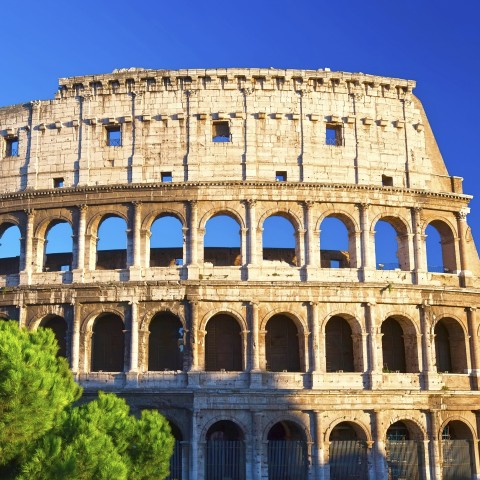
Timeless beauty
It was built around 80 AD and could hold an average of 65,000 spectators. There, they observed not only gladiator fights but also impressively hi-tech shows for the time, such as mock sea battles (where the whole theater was entirely filled with water!) and dramas based on Roman mythology.
The Colosseum clearly reflects the architectural and construction concepts of the early Imperial Age. This is particularly evident in its use of curved and enveloping lines offered by the oval plan, and in the structural relationships of arches and vaults.
So, enter this truly colossal structure and let yourself be enveloped by the density of the emotions the spectators of Ancient Rome felt. Also be ready to endure two inevitable—and rather annoying—features around the Colosseum: long ticket lines and fake Roman centurions asking you for money in exchange for a tacky picture. You can avoid the first nuisance by buying the tickets online via this site. As for the second nuisance…sorry, you’re on your own for that!
2 – The Roman Forum and Palatino
The Roman Forum is a lovely sight, and its location right next to the Colosseum makes it very easy to visit both places on the same day. It used to be Rome’s political, juridical, religious, and economic center. It can be defined in all respects as the beating heart of Ancient Rome.
In the early days of the Republic, this was a chaotic place with food stalls, brothels, temples, and the Senate house. The food stalls were eventually replaced by shopping malls and courts, and the Forum became a ceremonial center under the Empire. Here, all the monuments, temples, and basilicas were concentrated. Today, you can even admire what remains of the temple built in honor of Julius Caesar.

The beating heart of ancient Rome
Not far from the Forum, you can visit the Palatino (“Palatine Hill”). It’s one of the seven hills of Rome and constitutes the oldest part of the city. It is a real open-air museum! According to Roman mythology, Romulus and Remus, the famous brothers suckled by the she-wolf who became the founders of the city, came to light on the Palatine Hill.
In any case, the Palatine Hill remains one of the most evocative places in the city, as it was the home of the ruling class of Ancient Rome and, later, of the Farnese family gardens. The pleasant green of the rich vegetation envelops the vestiges of the past and accompanies people on this historical journey. And from here, the view is just breathtaking.
3 – Trastevere
After a whole day among stones and ruins, nothing beats a cool night out in Trastevere. Rome can be a great lively city, but Trastevere shows that it has never lost its village atmosphere. It’s a colorful neighborhood along the Tevere, the river that cuts through Rome.
It used to be a working-class area and today is a funky, bohemian spot. It’s known for traditional and innovative trattorias, craft beer pubs, artisan shops, simple B&Bs, and budget hotels.
Here, you’ll find the intimate side of the capital. It’s a place of pastel red buildings with green ivy that hangs down from the facades of the houses, and squares full of cafes and pizzerias, with “front row” seating to observe the river and the life that flows around it.

Sunset on the Tevere
4 – Campo dei Fiori
Another option for spending your night is Campo dei Fiori, probably the oldest market in Rome. Every morning since 1869 (except on Sunday), the square has been filled with colorful stalls selling fruit, vegetables, meat, poultry, fresh fish and, as a matter of fact, fiori (“flowers”).
During the day, Campo dei Fiori is really the right place to buy Roman specialties or to stock up for a nice picnic in a park. But at night, the square turns into one of the meeting places for nightlife, the perfect place to enjoy a drink or something to eat in the many outdoor cafes and restaurants.
Vatican City
Vatican City is definitely one of the best things to see in Rome. It’s a town in its own right, and is in fact a different state. When you enter St. Peter’s Square or the Vatican Museums, you cross the state border from Italy to the Vatican. It’s a very little state, considering that, apart from the Pope, it has only another 850 or so citizens, most of them being cardinals, diplomats, and guards.
Despite its small size, the Vatican City is visited every year by thousands of tourists, either for religious reasons or to get a glimpse of its many artistic treasures.
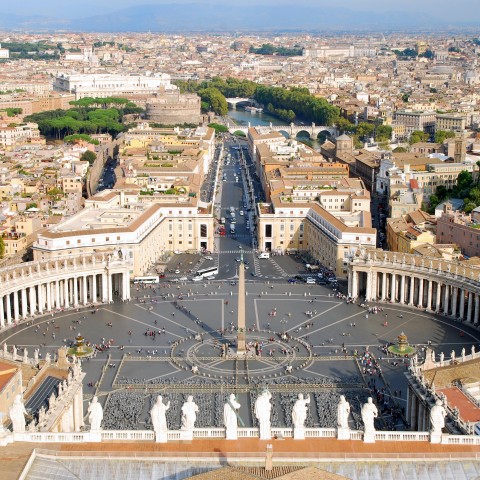
View from the top of the Basilica
5 – Piazza San Pietro e i Musei Vaticani
Once in the Vatican, you cannot miss St. Peter’s Square and the Basilica. The square is huge and from its center, you can see the most famous windows in the world, the ones from which the Pope looks out of every Sunday to give his blessing to thousands of followers. It’s also the window from which the most well-known sentence in Latin is announced after the successful election of a new head of the Catholic Church: “Habemus Papam…” (“We have a new Pope…”).
St. Peter’s Basilica is the largest church in the world and it’s considered one of the most sacred Catholic shrines as, according to tradition, Saint Peter’s tomb is supposedly right below the high altar of the basilica.
If you can, don’t miss the chance to go to the top of the dome, where you’ll have a fantastic view of the whole city, as well as the chance to see the Basilica and the square from above.
To visit the Vatican Museums, it’s best to arrive very early and/or to buy a skip-the-line ticket because it gets very crowded around midday. There is a lot to see and you can easily spend the whole day there, but you can opt to “limit” your visit to the Sistine Chapel and the fabulous Double Helix Staircase. If you have limited time or the lines are too long, keep in mind that you can also try a virtual tour.
- → Word of caution: Shorts, mini-skirts, and tank tops are not allowed in most churches, so think about the right dress code before visiting the Vatican…
6 – Castel Sant’angelo
A nice walk from St. Peter’s Square, the Castel Sant’Angelo was originally built as a mausoleum for the emperor Hadrian and it has overlooked the Tiber River for almost two thousand years. In this time, it has evolved from its initial role as a tomb, becoming a fortress, then a castle, and finally a museum.
Today, it’s open to the public and you can climb to the top for a splendid view of the city. You’ll also be able to admire the construction techniques that have allowed it to survive for two millennia.

From mausoleum to castle to museum
Central Rome
7 – Piazza Navona
Piazza Navona is among the most famous places to visit in Rome, built on commission from the Pamphili family. It is the best example of Roman Baroque style. Like many piazze in Rome, this location boasts a lovely central fountain. This was sculpted by Bernini and is enriched with an Egyptian obelisk made of a unique block of stone where the four largest rivers in the world are represented.
If you happen to visit Rome during Christmas or the other winter holidays, don’t miss the traditional market and street artists.
8 – Pantheon
The Pantheon is an imposing temple dedicated to all the Roman gods, originally built in 27 BC! It is a unique building due to its shape and dimensions.

The House of all Roman gods
The Pantheon has a circular shape, in front of which there is a classical colonnade. The dome has the particularity of not being completely closed: there is an opening at the top, called oculus (“eye” in Latin), that functions as a sundial—the sun, passing through the oculus, marks the passing of the hours and seasons. And when it rains? Well, the inside gets wet but, thanks to a series of holes in the floor, the water flows away.
The dome of the Pantheon is considered the biggest in the world, with a diameter of over 43 meters and a weight of 5000 tons. It’s considered among the largest in the world, and it undeniably constitutes a masterpiece of engineering and architecture, especially if we take into account the period in which it was built.
9 – Fontana di Trevi
From the Pantheon, you can easily get to the Trevi Fountain. Over the years, this fountain underwent many changes and was rebuilt several times, but the final version presents us with another great example of the Roman Baroque style.
It is one of the symbols of the Eternal City, as well as the largest and most spectacular of the Roman fountains with a width of 20 meters and a height of 26 meters. This extraordinary work celebrates the wonderful and changing world of water. Approaching la piazza, you can already hear the sound of the water, which creates a breathtaking view as it flows from the white stone.
There are many legends told about the famous Trevi Fountain, but the best known is certainly the one that claims if you throw a coin into the fountain (strictly from over your shoulder), you will surely return to Rome. And a lot of people throw coins in this fountain; an estimated one and a half million euros are collected each year from the fountain. Where does it all go? A part goes to the Caritas and a part to the maintenance of the city’s cultural heritage.
Don’t do this, unless you want to get a fine!
And of course, there’s the cinema, Fellini, Mastroianni, Anita Ekberg, and La Dolce Vita. But don’t try to imitate that, or you’ll get a fine!
10 – Piazza di Spagna (Spanish Steps)
To wrap up our trip around the ten must-see places in Rome, let’s go to Piazza di Spagna. Another masterpiece of Baroque architecture, it opens at the end of the luxurious Via Condotti and, in the center, the Barcaccia Fountain and the majestic Spanish Steps.
The fountain was built by Bernini and owes its shape to a legend that says a real boat was found there, perhaps brought by a strong flood of the Tiber. Barcaccia, in fact, means “the big ugly boat.”
The monumental 136-step staircase was built in 1725 to connect the church of Trinità dei Monti, located at the top, to the Spanish Embassy in the square. The best time to visit is in the morning, because of the beautiful light, especially on spring days with blue skies when the staircase is covered with azaleas!
The staircase was to be used not only as a passageway, but as a place to stop and sit. However, a new regulation has recently come into force that prohibits sitting (and especially eating) on the ladder, so be careful!

A night out, Italian style
Survival Italian Phrases for Travelers
Now for the elephant in the room: Can you visit Rome without knowing Italian?
In Rome, there will be people speaking English at most tourist attractions (though possibly with a thick Roman accent), but don’t expect that everybody on the street or in small venues and stores will be able to understand. This is actually good news, because you will be able to practice your Italian. And ItalianPod101 will be with you all the way!
Here is a list of essential survival phrases in Italian for your trip:
| Buongiorno! Buonasera! | “Hello!” / “Good morning!” “Good evening!” |
| Arrivederci. | “Goodbye.” |
| Grazie (mille). | “Thank you (very much).” |
| Non parlo Italiano. | “I don’t speak Italian.” |
| Per piacere. / Per favore. | “Please.” |
| Scusa. / Mi scusi. | “Excuse me.” |
| Mi dispiace. | “(I am) sorry.” |
| Dov’è il bagno? | “Where are the toilets?” |
| Può ripetere per favore? | “Can you repeat (please)?” |
| Quanto costa? | “How much is it?” |
| Vorrei questo. | “I would like this.” |
| Parla inglese? | “Do you speak English?” |
These are just some basic phrases to help you get by. For more on this topic, be sure to check out our survival guide on Italian Travel Phrases.
When in Rome… (Common Slang Expressions Used in Rome)
While walking around the Roman Forum or sipping a beer in Trastevere, you might hear some Roman expressions that you don’t understand. This is because people in Rome use a lot of colloquial slang called romanesco. It’s not a dialect, just a collection of common expressions used in Rome.
Here are the six most common expressions that you might hear during your visit:
| Aò! | Ciao! | “Hello!” |
| Ammazza! | Addirittura! | “Wow!” |
| Daje! | E dai! | “Come on!” (irritated) |
| Anvedi! | Guarda! | “Check it out!” |
| Annamo. / ‘Nnamo. | Andiamo. | “Come on.” / “Let’s go.” |
| Mortacci tua / ‘tacci tua | A highly offensive, but very common insult. You will hear it a lot, but don’t use it! 😉 | “Your ancestors” (cursing) |
Conclusion
After reading this guide, you’re ready to visit one of the most wonderful cities in the world: Rome! When you go, tell us all about your adventures in the comments below. Did you discover any hidden treasure? Were you able to practice your Italian (or even your romanesco)?
In any case, make sure to explore ItalianPod101.com, as we have plenty of free resources to help you practice your grammar and learn new words before you visit Italy. And when you go, don’t forget to bring with you our awesome mobile apps. Our vocabulary lists are another great way to review words and learn their pronunciation.
Happy learning, and enjoy your travels in Rome!

Itanglish: A Guide to English Words Used in Italian

Languages are influenced by a variety of factors, and words often travel from one language to another by way of loans, borrowings, translations, and general misuse. Some languages, including English and Italian, have had more of an influence on the world than others and are widely used (and misused) the world over. Italian has been influencing other languages, especially English, for a rather long time. This influence mainly appears in the fields of music, food, and science.
Today, there are also several English words used in Italian. This English influence on Italian is more recent, resulting from the huge influence that British and North American culture have had on our old continent in the last few centuries. Italians have borrowed many words, but sometimes these borrowed words are endowed with a somewhat different meaning than that of the original.
In this article, we’ll guide you through the different word exchanges between English and Italian. You’ll see that studying these commonly used (and misused) words can give you a head start in your vocabulary-building and help you communicate easily even as a beginner.
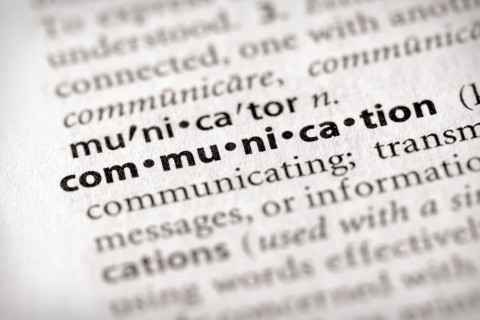
English, Italian, or Itanglish…as long as we communicate!
 Table of Contents
Table of Contents
- Loanwords
- Introduction to Itanglish
- Do You Speak Itanglish?
- English Words Derived from Italian
- Conclusion
Loanwords
We may not even realize it, but loanwords are everywhere and we use them all the time. But what exactly are they? A loanword is defined as a word that has been borrowed from another language. For example, an English word that becomes incorporated into another language (like Italian) without translation would be considered a loanword.
So, don’t be puzzled if you’re walking around Milan one evening and hear someone say:
- Dove butto il chewing gum? (“Where do I throw the chewing gum?”)
Or:
- Durante l’happy hour offrono sandwich e cocktail. (“During happy hour, they offer sandwiches and cocktails.”)
Even though half of the words are English, these are perfectly correct Italian sentences.
Of course, you could have said: Dove butto la gomma da masticare? and Durante l’aperitivo offrono panini e bibite alcoliche, but nobody speaks like that anymore. This is because some words have entered the common vocabulary with such force that using the original Italian word sounds a bit old-fashioned.
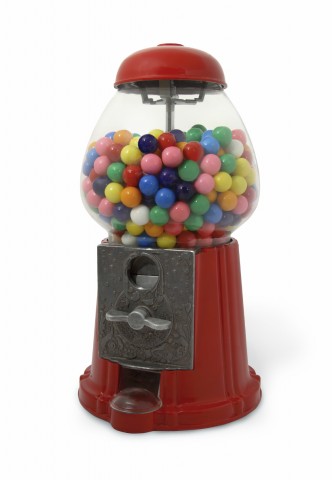
Chewing gum o gomme da masticare?
Although Italian has lent a great number of words to every other language, some “purists” hate to see our language “contaminated” by other languages. This feeling is especially strong toward Anglicisms, which they believe there are way too many of these days. But the reality is that languages change constantly and we have to accept the way people talk.
Here are some of the most commonly used English loanwords and their Italian equivalents.
| Sandwich | Hai portato i sandwich? (“Did you bring sandwiches?”) |
| Panino. It is rather funny that we borrow the English word for it, even though we have exported the Italian name for it all over the world… | |
| Cocktail | Vorrei un cocktail esotico. (“I would like an exotic cocktail.”) |
| Italians have always been more into wine, so maybe that’s why there is no real equivalent for this word unless you make a huge periphrasis: mistura di bevande alcoliche con succhi o frutta e ombrellini (literally: “mixture of alcoholic drinks with juice or fruit and small umbrellas”). | |
| Chewing gum | Non ingoiare il chewing gum! (“Don’t swallow the chewing gum!”) |
| Gomma da masticare. Nobody really says this anymore, but you may hear people call it gomma or cicca in some parts of Italy. | |
| Happy hour | A che ora è l’happy hour? (“What time is the happy hour?”) |
| Aperitivo or Apericena. They also sound happy, right? You can read our blog post on Untranslatable Italian Words if you want to learn more about apericena and other words that cannot be easily translated. | |
| Smartphone | Ho comprato uno smartphone nuovo. (“I bought a new smartphone.”) |
| Telefonino. This cute word was actually created as a name for the old-style cell phones, but it is still used today for the smart models. | |
| Chat | Ne parliamo in chat? (“Should we get on a chat?”) |
| If you chat in person, it’s chiacchiere, but there is no Italian equivalent for chatting over the internet. That said, you can ‘Italianize’ the word “chat” by conjugating it as a regular verb: chattare (io chatto, tu chatti, lui/lei chatta, ecc.). | |
| T-shirt | Che taglia è questa t-shirt? (“What’s the size of this T-shirt?”) |
| Maglietta (a maniche corte). | |
| Weekend | Cosa fate per il week-end? (“What are you doing for the weekend?”) |
| Fine settimana. | |
It’s interesting to note how Italians use these English words with different syntactic rules. For example, we don’t add -s to make them plural (i sandwich, gli smartphone, le t-shirt) and we do assign them the same gender as the Italian equivalent:
- il panino → il sandwich
- la maglietta → la t-shirt
- il fine settimana → il weekend
All of the words above have been used for decades and are part of everybody’s daily vocabulary. But there are other loanwords that have recently entered the jargon of young Italians and professionals of the new economy.
It’s considered “cool” to use the English equivalents of these words, even though they have perfect Italian equivalents. So be aware: if you’re in an Italian work environment, you might actually end up listening to a lot of English words!
Il marketing del brand del “Made in Italy.” (The marketing of the “Made in Italy” brand.)
| Marketing | Lei è il nuovo direttore marketing? (“Are you the new marketing director?”) |
| Vendita. Of course, “marketing” refers to everything that has to do with selling strategies and all the communication that goes with it. | |
| Business | Dobbiamo fare crescere il business. (“We need to grow our business.”) |
| Affari, attività economica. This word is also widely used in combination with other words, as in: business class, business school, core business, and show business. | |
| Brand | Ferrari è il brand più forte al mondo. (“Ferrari is the world’s strongest brand.”) |
| Marchio. It is not uncommon to hear people talking about il brand del “Made in Italy.“ Believe it or not, that is a correct Italian sentence! | |
| Meeting | Il meeting è alle tre. (“The meeting is at three.”) |
| Riunione. Besides being used in the workplace, it is also used for some sporting competitions, such as in: il meeting di atletica (“the track and field competition”). | |
| Briefing | Hai letto il briefing di oggi? (“Did you read today’s briefing?”) |
| Istruzioni brevi. Did you know that the term “briefing” originally derives from the Latin brevis (“short”)? And now it has returned to Italian as a loanword… | |
| Know-how | È importanto valorizzare il know-how. (“It is important to enhance the know-how.”) |
| Competenze. | |
| Gap | Il gap salariale è troppo alto! (“The retribution gap is too high!”) |
| Divario, dislivello. | |
| Coffee break | Ci meritiamo un coffee break. (“We deserve a coffee break.”) |
| Pausa caffè. Even if you only need a few seconds to drink an espresso ristretto, it doesn’t mean you have to miss out on a longer break. 😉 | |

Time for a coffee break (a rather old time…).
Introduction to Itanglish
All of the loanwords we’ve seen so far tend to make sense. They are common, they are universal, and they help us communicate. But some words have taken on a life of their own to form a ‘language’ called Itanglish. This consists of English words that are used in Italian communication on a daily basis, but with a twist.
This is a rather interesting phenomenon and one that exists in every language. Basically, for some mysterious reason, an English word enters the Italian common use but with a slightly different meaning from the original word. In the end, the word looks and sounds English, but it is not English anymore because its meaning is altogether something else. Now, the origin of the meaning of these words is difficult to trace back, but the fact is that everybody in Italy agrees on the same meaning.
Do You Speak Itanglish?
These words are a great source of comedy because Italians will use them with the definite conviction that any English speaker will know exactly what they mean. But nothing could be further from the truth. The reality is that, out of context or without the help of the proverbial Italian gestures, nobody will understand… Here are some examples of English words used in the Italian language that might confuse you at first glance.
| Zapping | From the verb “zap,” meaning to destroy your enemy, it has become “to change channels compulsively with your remote control” in Itanglish. |
| Smetti di fare zapping! (“Stop changing channels!”) | |
| Footing | In English, this can refer to the action of moving by foot (“she was seen footing across the field”). It is also used to describe the state of one’s feet having a secure grip on something (“I nearly lost my footing”). For some reason, it is used as a synonym for jogging, or correre, in Itanglish. |
| Faccio footing ogni mattina prima di andare al lavoro. (“I jog every morning before going to work.”) | |
| Smoking | How do you get from “smoke” to dinner jacket or tuxedo? Beats me…but this is the meaning of the Itanglish word! |
| Mio padre metteva lo smoking per andare a teatro. (“My father wore a tuxedo to go to the theater.”) | |
| Flipper | A flipper is a pinball machine. Well, I guess what happened here is that since the little fins you operate to throw the ball back are called ‘flippers,’ the whole machine took that name in Itanglish. |
| Mi piace giocare a flipper. (“I like playing with the pinball machine.”) | |
| Box | We all know what a box is, right? Well, not exactly… In Itanglish, box has become a small enclosed space, like a garage for a car or a box doccia (“a shower cabin”). |
| Questo appartamento è dotato di un box? (“Does this apartment come with a garage?”) | |
| Mister | No, we are not talking about just any man. In Itanglish, the mister is one specific man: the coach (also known as allenatore) of a team. This is normally used for the coach of a soccer team. |
| Il mister ci ha fatto i complimenti per la partita. (“The coach praised us for the game.”) | |
| Spider | You don’t like spiders? I bet you’ll like these, though. In Itanglish, this word refers to a two-seat sports car. So how do you go from a car to a spider? Apparently, in the past, the disproportion between the size of the tires and the small cockpit made them look like spiders… |
| Il mio sogno è avere una spider rossa. (“My dream is to have a red sports car.”) | |
| Toast | When you think of toast, a single slice of slightly toasted bread comes to mind. But in fact, if you ask for a toast (pronounced un tost) in Italy, you will receive two slices of toasted bread with ham and cheese between them. |
| A pranzo ho mangiato solo un toast. (“I just ate a ham and cheese toast for lunch.”) | |
| Golf | If you’re thinking of long afternoons playing on green grass, think again. Because for some strange reason, Italians use un golf to refer to a light woolen pullover. Why? Who knows… And if you hear someone talk about un golfino, it’s just another cute way of saying the same thing. |
| Porta il golf che stasera farà freddo. (“Bring a pullover because it will be cold tonightl.”) | |
| Slip | Maybe because it means “to slide” or “to move quickly” in English, this word means “underwear” in Itanglish. It makes sense, right? And of course, if it is very small or belongs to a little child, it turns into lo slippino. |
| Ho comprato tre slip per 10 euro. (“I bought three pairs of underwear for 10 euros.”) | |
| Feeling | In Itanglish, this is a very particular emotional state. It is when there’s a spontaneous and immediate emotional bond between people…a special understanding. |
| Fra di noi c’è del feeling. (“There’s chemistry between us.”) | |
| Fiction | In English, fiction refers to any literature in the form of prose, such as novels or short stories, that tell a story not directly based in reality. But in Itanglish, it has taken on the meaning of “TV series.” Once upon a time, they were called sceneggiati. |
| Non posso perdere l’ultima puntata della mia fiction preferita. (“I can’t miss the last episode of my favorite TV series.”) | |

Basta zapping! (“Stop channel surfing!”…Let go of the remote!)
English Words Derived from Italian
How did you like speaking Itanglish? Well, you should know that there are also many Italian loanwords that are commonly used in English. Most of them belong to the realm of music, arts, food, and science.
Let’s review some of them:
→ From music
- Fiasco
- Soprano
- Opera
- Diva
- Piano
- Prima donna
- Concerto
- Finale
- Ballerina
→ From the arts
- Chiaroscuro
- Scenario
- Mask (maschera)
- Studio
→ From science
- Volcano (vulcano)
- Lava
- Influenza
- Medico
- Malaria
- Quarantine (quarantena)
- Tarantula (actually, from the city of Taranto)
→ From food (of course)
- Lasagna
- Spaghetti
- Pizza
- Broccoli
- Mozzarella
- Panino
- Pasta
- Gelato
- Pesto
- Granita
- Gusto
- and tons of others…
Conclusion
As you’ve seen in this guide, there are plenty of English words in Italian to help you start communicating even as a beginner! You’ve also seen some Itanglish words that will take some getting used to, but which will make your speech that much more natural once you do. Did we forget any important Itanglish word that you’ve heard before? Tell us about it in the comments!
Keep working on and having fun with your Italian studies on ItalianPod101.com, where you can find tons of vocabulary lists, free resources, and even mobile apps.
Remember that you can also use our Premium PLUS service, MyTeacher, to get personal one-on-one coaching. Your private teacher will guide you so that you always know what to study next, based on your needs and progress. He or she will provide you with assignments, personalized exercises, and recorded audio samples to help boost your progress. There is no faster way to learn Italian than with ItalianPod101!

An Overview of the Italian Culture

Culture is a broad concept encompassing all things relevant to a certain group.
If you’re studying the Italian language or planning to visit Italy, it’s extremely important to understand their habits, traditions, and ways of thinking. This is where our Italian culture overview comes in! We’ll inform you about Italians’ social behaviors, education, beliefs, arts, laws, and everything else that’s considered important in Italy. Essentially, we’re giving you the key to the soul of the Italian people. As you’ll soon see, culture is everything!
But what makes Italian culture unique? Well, Italy has been the heart of the Roman Empire and the seat of the Catholic Church, as well as the meeting point of many Mediterranean civilizations. This has steeped the nation in a wealth of knowledge and layers of historical influence. In addition, Italy has been the heart of many artistic movements, and it’s been considered one of the most flourishing cultural centers of Europe since ancient times.
Italy has a vibrant culture. Old and new coexist side by side, and not only because ruins from ancient times sit alongside metro stations or because you can see a Ferrari parked right next to an Ape Car selling fruits and vegetables. Since the Roman Empire times, tradition and innovation have always been important parts of the Italian culture.
 Table of Contents
Table of Contents
- Values and Beliefs
- Philosophies and Religions
- Family and Work
- Art
- Food
- Traditional Holidays
- Conclusion
1. Values and Beliefs
When you think of Italians, I’m sure that a very clear image comes to mind. This is because Italian culture is so widely known around the world that others’ perception of it sometimes ends up being a caricature. But in Italian culture, values and beliefs are the pillars of society. Here are just a few core truths of Italian culture:
→ Family is very, very important and it is at the core of all Italian life.
→ Italy is statistically old-aged and Italians hold elderly people in a position of respect, valuing their history and knowledge. People often rely on elders for help.
→ Sociability is important, and Italian people are sociable and outgoing. They like to form strict groups in which members help each other. Social life in Italy revolves around meals. There are even specific words used to indicate special social eating events with friends, such as aperitivo (an after-work get-together) and spaghettata (a late-night improvised pasta dish with friends).
→ Italians like to argue. Not necessarily to quarrel and fight, but just to argue for the sake of arguing. They argue about everything, but their favorite topics are of course politics, soccer, and food. It’s not by chance that Italy has hosted many famous philosophers, from Pitagora to Cicero and from Machiavelli to Gramsci—and many others in-between!
→ Work is very important, and Italians have always been a hard-working people. That said, they’re also well-known for their dolce far niente (“pleasant idleness”) and bella vita (“good life”) lifestyle. The importance of work for Italians is best expressed by the first article of the Italian Constitution, which states: L’Italia è una repubblica democratica fondata sul lavoro. (“Italy is a democratic republic founded on work.”)
→ Curiosity and innovation are definite Italian culture characteristics, having driven explorers (Christopher Columbus, Marco Polo) and inventors (Leonardo da Vinci, Galileo Galilei) as well as, in more recent times, the fashion and design industries.

The family and the church: the two main institutions in Italy.
2. Philosophies and Religions
Italy has long been the center of the Catholic world, since the day when Saint Peter settled in Rome and served as the first leader and bishop of the Catholic church. The Vatican is here and the church has always had a direct or indirect influence over Italian life and politics (especially in the past).
Perhaps the most influential person among spiritual leaders has been Saint Francis of Assisi, who is still often referred to as a role model for simple living and harmony with nature. The grandeur and influence of the Catholic church are evident in the beauty and number of churches, cathedrals, and domes that you can see everywhere, from major metropoles to small villages.
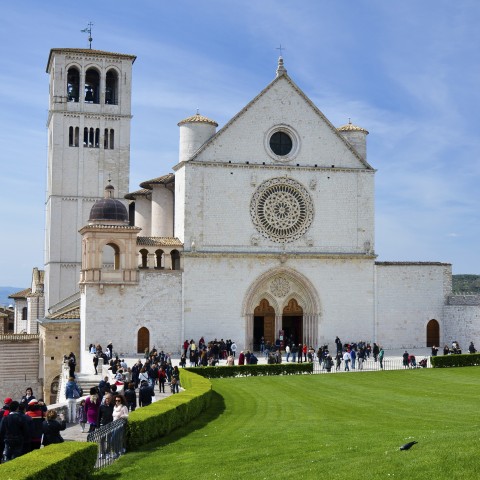
A church at every corner!
But even in the past, the church has often originated free thinking and rationalistic thought, both of which have surged to counteract the immense cultural power of the Catholic church. This explains the great number of philosophers and scientists that have populated the peninsula since ancient times, through the Middle Ages and Renaissance until today.
Nowadays, this influence is decreasing, especially since there has been a gradual distancing from Catholic rituals among young people. In addition, migration and new social mobility have introduced people of other religions. Recent statistics show that religion in Italy is increasingly diverse, with 80% of Italians being Catholics, 15% having no religion, and 5% belonging to a different religion (many of them Muslim from the migratory waves from North Africa).
- → Start expanding your Italian vocabulary with our free list of Religion names in Italian!
3. Family and Work
Family is the core of Italian culture and traditions. Food, holidays, day-to-day life…everything revolves around the institution of family. Despite having lost a little of its power as an institution in recent years, it’s still central to the Italian culture and way of life.
Families are tight. Grandparents often take care of their grandkids, and sons and daughters live at home even if they’ve already started their professional careers. After all, living with mamma e papà (“mom and dad”) is sooo comfortable, why leave?
Italian families also argue and fight a lot. For proof of that, you can just check out the immense quantity of dramas and comedies about dysfunctional families, usually gathered around a table at some traditional event.
Arguments are often due to the fact that Italian parents are very protective of their children and they want to take care of their children’s education, work, finances, and feelings. Even as adults, Italians like to ask for their parents’ opinions and to involve them in very personal matters.
At work, Italians tend to recreate a family-type group. Community, gossip, fun, and empathy all go on at once in an Italian workplace. Italians are very hard-working, but they try to carry out their tasks with a smile and by mixing work with pleasure (l’utile e il dilettevole).
The Italian job market is quite unstable and Italians often end up working in the family business or having to look for better opportunities abroad. This is something that Italians have done for centuries, often populating and helping to develop other countries.
- → Learn the Must-Know Italian Terms for Family Members and words for Talking About the Workplace with ItalianPod101.com.
4. Art
Italy is art!
This is something that Italians can really be proud of, as the country hosts the highest number of UNESCO World Heritage Sites (55). Not to mention that half of all the world’s greatest artwork is in Italy!
It’s no wonder the Stendhal syndrome was born here: the French author/poet was visiting Florence when he experienced a rapid heartbeat, sense of fainting, and confusion due to being exposed to too many beautiful things. Italy is home to more than 100,000 monuments, churches, cathedrals, archaeological sites, houses, and statues, not to mention all of the paintings, frescos, and sculptures in the museums.
In Italian culture, art has always been an essential aspect of life. One of the reasons why Italy has so much art could be traced back, once again, to the presence of the Vatican and to the great power (and money) that the Church had from the Middle Ages on. Often, in fact, Popes and Cardinals were the ones that ordered and paid for artwork intended to celebrate God and the Church itself. This is how many Italian cities, such as Rome, Florence, and Milan became known for big artistic centers where artists gathered in search of fame and commissions.

Mmm…something is not quite right here…
Another artistic area that is strongly representative of Italian culture is music. Music is everywhere and Italians like to sing and dance. It’s not by chance that many of the words used to talk about and describe music come from Italian. Also, many of the classical instruments, such as the piano and the violin, were invented in Italy.
Italian music is very melodic and often dramatic. In the 1800s, Italy contributed to the world of music by creating the most memorable of all classical music styles: the Opera! Verdi, Rossini, Puccini…who doesn’t know of them and their music?
If art is your thing, Italy is the place to be.
5. Food
“Food” and “Italian” are two concepts that just go naturally together.
Italy is home to both the simplest, traditional home cuisine, and the most sophisticated and starred dishes. It’s the typical yin-and-yang characteristic of Italian life: buono e bello, utile e dilettevole, lavoro e piacere (“good and beautiful, useful and delightful, work and pleasure”).
In Italy, food is at the center of celebrations and family gatherings. In the past, the most important meal was il pranzo (“lunch”). It’s still common for families to get together around a table on Sundays to celebrate il pranzo della domenica (“Sunday’s lunch”) with the typical succession of antipasto, primo, secondo, contorno, frutta, dolce e caffè (“appetizer, first course, second course, side dish, fruit, dessert, and coffee”).
Meals on special occasions can go on for hours. Eating is not just about food and nourishment, but rather about pleasure, indulgence, and being with loved ones to share in each other’s joys.

Pizza, spaghetti, gelato, espresso: Italian culture at its best!
Italians are extremely proud of their gastronomy, and every region, city, and village boasts its unique cuisine. Flavors and traditional preparation methods are very important; Italians try as much as possible to preserve and protect their culinary products. This is what the acronyms DOP, DOC, and DOCG stand for: they certify that the origin of a specific product is protected, checked, and guaranteed. You’ll often find these acronyms on wine and cheese products.
There are probably four things that immediately make people think of Italy: pizza, spaghetti, gelato, and espresso. And what else do you need in life?
- → See our vocabulary list titled What’s Your Favorite Italian Food? to learn what else to expect from Italian cuisine!
6. Traditional Holidays
Holidays are an important part of Italian culture, and they end up combining all of Italy’s best cultural aspects.
Holidays are when families gather around special, traditional, and seasonal foods. Most holidays in Italy have a Catholic origin and these traditions are often honored in theatrical religious functions or rituals.
In Italian culture, holidays are the perfect “excuse” to bring out the best of the Dolce Vita, that particular way Italians enjoy life to its fullest. Italians usually celebrate all major holidays with family, gathered around the table. There’s a popular saying regulating which holiday you should spend with family: Natale con i tuoi, Pasqua con chi vuoi (“Christmas with your family, Easter with whoever you want”).
Some of the traditional holidays are very typical of Italy, such as la Befana. This is the Epiphany on January sixth, when an old and ugly lady on a flying broom brings candies to children. Another popular holiday is Pasquetta, the Monday following Easter Sunday, when tradition calls for a picnic in the countryside.
Another very Italian holiday is Ferragosto on August 15, which is a celebration of the end of summer. If you’re traveling through Italy on Ferragosto, beware that everything is closed, nobody is around, and the country is practically shut down for the holiday.

The Frecce Tricolori during a June 2 celebration
As far as national celebrations go, two very important dates are:
- April 25: La festa della liberazione (“Liberation Day”)
- On this date, we remember Italy’s liberation from the fascist regime.
- June 2: La festa della Repubblica (“The Day of the Republic”)
- On this date, we remember when Italy became a Republic by means of a Referendum in 1946.
7. Conclusion
In this guide, we showed you the most important aspects of Italian culture, from its core values to religion, social life, history, art, food, and holidays. Do you have any questions about something we covered? Are there any other cultural aspects you would like to learn about? If so, leave a comment below and we’ll be happy to elaborate!
And remember: Culture and language go hand in hand, so diving deeper into the Italian culture will help you learn the language (and vice-versa!).
Another sure way to improve your Italian is to explore ItalianPod101.com and take advantage of all our free resources to practice the language and improve at your own pace. You can learn with a great variety of vocabulary lists and even with apps for your phone.
And if you want a more personalized teaching approach, check out our Premium PLUS service, MyTeacher. You’ll get personal one-on-one coaching with your private teacher who will help you practice with personalized exercises. He or she can also record audio samples for you to help with pronunciation, and review your own recordings.
Happy Italian learning!

The 25 Most Well-Known Italian Quotes

Quotes are the perfect way to go deeper into the cultural wealth of a language. They give us a clear vision of people’s philosophy, mindset, history, and popular culture. This means that by studying Italian quotes, you’ll not only be able to better understand the people around you and better express yourself, but you’ll also be able to explore Italian culture at a deeper level.
In this article, we’ll go through the most commonly used Italian quotes, from sayings about love to words of traditional wisdom.
 Table of Contents
Table of Contents
- Quotes About Success
- Quotes About Life and Wisdom
- Quotes About Love
- Quotes About Family and Friends
- Quotes About Food
- Dante’s Quotes
- L’importante è finire!
1. Quotes About Success
We’ll start our list with a few Italian quotes of strength and success. How can you apply these to your everyday life?
1. Veni, vidi, vici.
(“I came, I saw, I conquered.”)
In Italian, it’s: Venni, vidi, vinsi.
This is probably the oldest and most memorable of all the popular Italian quotes, and it comes from ancient Italian times (and more precisely, from ancient Rome). The original quote is in Latin, coined by Julius Caesar to describe one of his many quick and easy military victories. Today, this quote has—fortunately—lost its military connotation, but it continues to be commonly quoted in its original Latin form to describe great personal achievements that were accomplished quickly and without much effort. Does it sound like bragging? Well, yeah! After all, it is Julius Caesar we’re talking about!

I came, I saw, I conquered.
2. Il fine giustifica i mezzi.
(“The end justifies the means.”)
Success, particularly in the political realm, was what Machiavelli had in mind when he wrote this famous and oft-quoted phrase. This sentence has been used since the Renaissance to depict a type of political system that would resort to every evil means in order to reach its goals, no matter the costs. This isn’t exactly what Machiavelli meant, but it doesn’t matter much anymore since it’s such a widely known concept. There was even an adjective created to illustrate this very idea: machiavellico (“Machiavellian”).
3. La calma è la virtù dei forti.
(“Calm is the virtue of the strong.”)
But success is not derived from military strength or political ability alone. On the contrary, a very old saying (the origin of which is now lost) tells us the secret to being strong and successful: be calm, be sure of yourself, and face any situation. It’s basically another way of saying “Keep calm and carry on,” the famous phrase from a 1939 poster made by the British government before World War II.
2. Quotes About Life and Wisdom
Now let’s look at some Italian quotes about life from some of Italy’s greatest minds and artists.
4. La semplicità è l’ultima sofisticazione.
(“Simplicity is the ultimate sophistication.”)
When talking about life and wisdom, it just makes sense that we quote one of the wisest, most intelligent, creative, and brilliant minds of all times! Have you guessed? Of course, we’re talking about Leonardo da Vinci! He loved to say that la semplicità è l’ultima sofisticazione (“simplicity is the ultimate sophistication”), or in other words, “keep it simple” or “less is more.” This seems like very good advice for anybody in any situation—and in any case, anything that good old Leonardo said will make you look good!
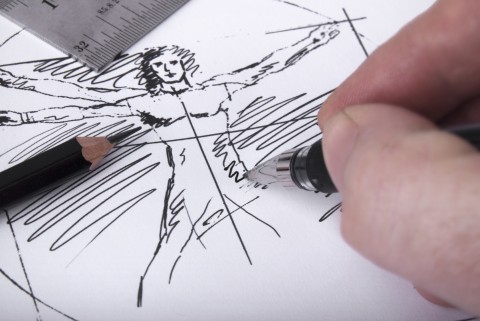
Keep it simple, says Leo Da Vinci!
5. Dietro ogni problema c’è un’opportunità.
(“Behind any problem, there is an opportunity.”)
Galileo Galilei, another great scientific and philosophical mind of the Renaissance, brought us this very modern-sounding quote. He probably had no idea that this concept would be used five centuries later by managers and marketers all over the world, all agreeing with the advantage of turning problems into opportunities.
6. La libertà è come l’aria: ci si accorge di quanto vale quando comincia a mancare.
(“Freedom is like air: you realize its value only when you miss it.”)
Next is the jurist Piero Calamandrei, one of the most prominent protagonists of la Resistenza (“the Resistance”). His quote is true of many things: you miss them when they’re gone. But the quote gains significance when we talk about freedom, one of the vital elements of life, just like air.
7. Se comprendere è impossibile, conoscere è necessario.
(“If understanding is impossible, knowing is necessary.”)
And from the same historic time—the aftermath of WWII—comes another memorable quote, this time from the novel Se questo è un uomo (“If This is a Man”) by Primo Levi. Talking about his experience as a survivor of a concentration camp, he underlines the importance of remembering and studying the absurd tragedies of the past.
8. Se non hai mai pianto, i tuoi occhi non possono essere belli.
(“If you haven’t cried, your eyes can’t be beautiful.”)
Wisdom can come from many different sources. You don’t need to be a scientist or a philosopher to say something so beautiful and meaningful that people cite it for years to come. For example, this quote of simple popular wisdom is from the mouth of the beautiful Italian actress Sophia Loren. It entails the notion that real beauty has the depth of life, and suffering is a part of living.

Did you know that crying can make you beautiful?
3. Quotes About Love
Italian quotes about love… We can’t talk about this without making a reference to the delicious Baci Perugina. These are chocolate and hazelnut pralines that, since the 1920s, have made the perfect romantic present. They’re individually wrapped in popular literary love quotes that are translated into four languages. In Italy, they’re synonymous with romanticism (or cheesy pickup lines, depending on who you ask…).
But no love quote is more famous than this one:
9. Amor ch’a nullo amato amar perdona.
(“Love that exempts no one loved from loving in return.”)
Considering that Dante wrote this quote in his Divina Commedia in 1320, it’s not very easy to understand. But it basically means that love has a powerful way of attracting love. The rhythm of this verse is so beautiful that people like to quote it just to hear the sound. Give it a try!
10. Siamo angeli con un’ala sola: possiamo volare solo se abbracciati.
(“We are one-wing angels: we can only fly together.”)
Not as old as Dante’s quote but just as poetic, is this quote from the Neapolitan actor, director, and writer Luciano De Crescenzo, in his film Così Parlò Bellavista. It’s a beautiful metaphor of the force of true love.
11. L’amore è cieco.
(“Love is blind.”)
Italians often quote this universal concept of love to justify an improbable relationship. Lately, people have added another small pearl of wisdom to the sentence: L’amore è cieco…ma la sfiga (la sfortuna) ci vede benissimo! (“Love is blind…but bad luck sees perfectly well!”). This addition actually comes from one of the Murphy’s Law books by Arthur Bloch.
4. Quotes About Family and Friends
You all know how important family is to Italians—especially the family members that gather around a table on special occasions! Family isn’t limited to our immediate relatives, but includes all of its members, close or distant. Nowadays, Italian families have a tendency to be more and more extended. The bottom line is that every family is different and none of them are “normal.”
There are many Italian quotes about family (and several proverbs) that discuss the sweet and sour dynamics of family life.
12. Si può fare tutto, ma la famiglia non si può lasciare.
(“You can do anything, except leaving your family.”)
This may be another way of saying that we don’t choose our family and that family ties are stronger than anything. Or so believed Gianni Agnelli, whose family owned the Italian automotive giant Fiat (which is today Fiat-Chrysler). And it’s no wonder he would say that, since his family allowed him to be the richest man in Italy for decades!
13. Gli faremo un’offerta che non potrà rifiutare.
(“We will make him an offer he cannot refuse.”)
When talking about famous and powerful families, how could we forget the—fictitious, but quite realistic—Corleone family from The Godfather? This is by far the most memorable citation from the movie, and one that people quote all the time as a joke about making a very good offer of any kind. It goes without saying that Cosa Nostra is not something to joke about, but this quote has entered Italy’s everyday language.
14. Dagli amici mi guardi Iddio che dai parenti mi guardo io.
(“Lord, protect me from my friends; I can take care of my relatives.”)
We choose our friends, and we inherit our families. In the end, they are both very important to us—but they can be dangerous, too! Or at least that’s what the famous comedian Totò thought. You don’t know Totò? Well, he was “just” the most popular Italian performer of all time. He said this quote in a movie, paraphrasing an old proverb. If you want to learn all about crazy family and friend dynamics, just watch any of his old movies!

Nessuna famiglia è “normale.” (“No family is “normal.”)
15. Sai cos’è l’amico? Un uomo che ti conosce a fondo e nonostante ciò ti vuole bene.
(“Do you know what a friend is? Someone who knows you deeply and still loves you.”)
Vittorio Gassman gave us this quote about friendship in his movie Profumo di Donna (“Scent of a Woman”). It depicts the quintessential and bittersweet quality of the movie.
5. Quotes About Food
Considering the prominent food culture in Italy, it should come as no surprise that Italian food quotes are very common. Here are some of the best Italian quotes about food!
16. Buono come il pane.
(“Good as bread.”)
Italian food is the celebration of simple flavors, and this concept is best illustrated through this quote. Simpler things are the best, and bread is the greatest example of honest, traditional, and good qualities. This saying can apply to people as well!
17. Non si vive di solo pane.
(“We do not live by bread alone.”)
Bread is great, but according to this traditional saying, it’s just not enough…
18. La vita è una combinazione di pasta e magia.
(“Life is a combination of pasta and magic.”)
Nobody can describe the beauty of life better than the Maestro Federico Fellini, who summed it all up in this quote. What else is there to say? Genius!
19. Altro il vino non è se non la luce del sole mescolata con l’umido della vite.
(“Wine is nothing but sunlight mixed with the humidity of the vine.”)
Or maybe we can just add another element to Fellini’s formula with Galileo Galilei’s definition of wine. It just reminds us how important nature is in all aspects of our life.
20. L’uomo passa la prima metà della sua vita a rovinarsi la salute e la seconda metà alla ricerca di guarire.
(“Men spend the first half of their life ruining their health and the second half trying to fix it.”)
Pasta and wine are great, but better not overdo it. So it’s Leonardo Da Vinci to the rescue, reminding us to keep our future in view while we enjoy ourselves in the present! I bet we can all relate to this quote…

Is it pasta or is it magic?
6. Dante’s Quotes
Before wrapping up, we can’t forget to introduce the most common and widespread citations by Italians. When it comes to Italian quotes, Dante’s Divina Commedia is a major source of modern-day quips. Maybe it’s because it was the first literary work written in Italian, or maybe because Italians have to study it inside and out for school. Perhaps it’s because he really was the greatest Italian poet.
Dante’s quotes can sometimes be obscure. They’re written in archaic Italian, and they’ll definitely make more sense if you read the book…but we’ll provide you with the most popular quotes so you can show off to your Italian friends!
21. Nel mezzo del cammin di nostra vita mi ritrovai per una selva oscura.
(“In the middle of my life I found myself in a dark forest.”)
Let’s start with the very first sentence of his Divina Commedia. You’ll hear this citation quoted all the time in reference to any difficult situation (the dark forest) that a person has experienced at some point in life (in the middle of my life).
22. Galeotto fu il libro e chi lo scrisse.
(“Guilty was the book and who wrote it.”)
This quote is used to refer to a person, an object, or an event that made a relationship possible.
23. Lasciate ogne speranza, voi ch’intrate.
(“Leave all hope, you who are entering.”)
This grim phrase was written on the door of hell, making it clear that there was no coming out once you went through that door. But today, it’s a favorite quote for students who are about to enter their classroom, used as a joke about the desperation of being in school-hell! 🙂
24. Non ti curar di lor, ma guarda e passa.
(“Don’t pay attention to them, but observe and move on.”)
This quote is used to mean that one should be superior and not worry about what others do, think, or say.
25. L’amor che move il sole e l’altre stelle.
(“Love that moves the sun and the other stars.”)
Let’s conclude with a cosmic love citation, giving us the feeling of just how important love is. Love is all we need! And, from the Middle Ages to today, that hasn’t changed!
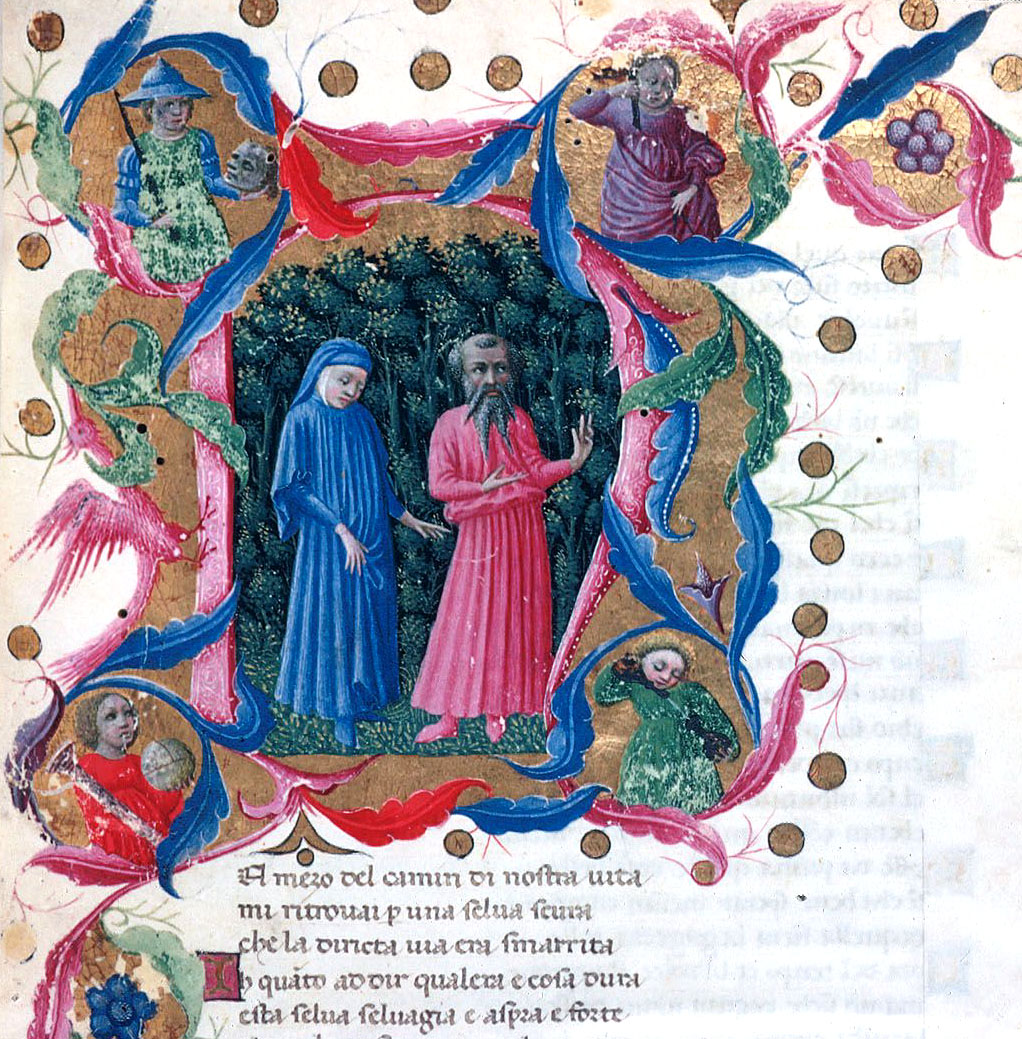
7. L’importante è finire!
“The important thing is the end” sang the famous Italian singer Mina in the 60s. We hope you enjoyed learning the most important and common Italian quotes on success, wisdom, love, family, and much more.
Do you want to learn more quotes and citations? Do you have something specific in mind? Make sure to share them with us in the comments below!
ItalianPod101.com also has tons of free vocabulary lists with audio recordings and free resources to improve your Italian in a fast and fun way!
Remember that you can also use our Premium PLUS service, MyTeacher, to get personal one-on-one coaching, personalized assignments and exercises, and tailored materials to help you dramatically improve your language skills. Check it out!

Italian Business Language for Doing Business in Italy

Did you land the perfect job in an Italian design firm? Do you want to start expanding your business in Italy? Are you applying for a job in Rome and need to update your CV and interviewing skills with the proper Italian business language?
We know that workplaces, job interviews, and starting a new job can be stressful. And what about talking on the phone with a client or boss? Not to mention the art of writing the perfect email or a convincing CV. Now imagine having to manage all of this in Italian…
If you want to succeed in any of these activities, you’ll need to master the basic Italian business phrases and vocabulary.

Let’s do business with style!
But don’t worry! We’ve put together this practical guide on how to succeed in the Italian business world. We’ll guide you through all you need to know to be at your best in the most common business situations.
 Table of Contents
Table of Contents
- First Things First
- Business Words and Phrases
- Nail a Job Interview
- Interacting with Coworkers
- Sound Smart in a Meeting
- How to Handle Emails and Business Phone Calls
- Go on a Business Trip
- Conclusion
1. First Things First
In any social situation, the first code that you have to learn is how to greet and address others. In a work or business situation, this is even more important. So let’s start by going over the correct way to meet and greet in Italian.
1 – Greetings
First of all, you’ll need to say hello. The best Italian business greetings for this are:
- Buongiorno (“Hello,” but literally “Good day”)
- This can be used in formal and informal settings, and it’s the appropriate greeting to use until the early afternoon.
- Buonasera (“Good evening”)
- This is the greeting that you start using in the late afternoon.
- Ciao (“Hello”)
- This is a very informal way of greeting, and it can be used only in situations where everybody is very informal, or if you know everybody very well.
Now, if you’re in a business meeting and need to introduce yourself for the first time, here are the most common formulas:
- Piacere (“Nice to meet you,” but literally “Pleasure”)
- It’s actually the shorter version of the next phrase.
- Piacere di conoscerla (“It’s a pleasure to meet you”)
- Molto piacere (“Really nice to meet you”)
- This is just another version of the same formula.
In professional settings, you’re expected to use the appropriate title to address professionals. Some examples include:
- Dottore / Dottoressa (“Doctor”) – This one is also used for anybody with a university degree.
- Avvocato (“Lawyer”)
- Ingegnere (“Engineer”)
- Architetto (“Architect”)
When it’s time to leave the office, just use the most common goodbye phrases:
- Arrivederci (“Goodbye”) is the best way to bid farewell in Italian, since it can be used in both formal and informal situations. Additionally, it can be used to address a single person or a crowd, as it literally means “We’ll see each other.”
- If you want to be more formal, use Arrivederla, which is the same formula, but using the Lei form (which we’ll review below).
- Ciao (“Bye”) is a good option if you’re very familiar with your coworkers. In Italian, it means both “hello” and “bye.”

Arrivederci!
2 – “Tu” or “Lei”?
Like other Romance languages, Italian has two different forms for addressing people in the second person, depending on the degree of familiarity or informality of the situation.
In professional settings, it’s normally expected for you to address everybody with the formal “you” (lei). Notice that while it looks like the pronoun for “she,” lei agrees with the gender of the person.
- Signor Rossi, Lei è mai andato in barca a vela? (“Mr. Rossi, have you ever sailed?”)
The rule of thumb is that you formally address all people that are older than you, those who are hierarchically higher than you, and unfamiliar people in formal settings.
Nowadays, especially in typically younger workplaces (startups, design firms, new-economy, etc.), it’s becoming more and more common to address everybody informally. But just to be sure:
- See if the people around you use tu or lei and do the same.
- Wait for your interlocutor to ask: Possiamo darci del tu? (“Can we switch to informal you?”).
2. Business Words and Phrases

Here is the most basic Italian business vocabulary you should know.
1 – The Company
Depending on your line of business, you probably work in one of these places:
- Una società / Un’azienda / Un’impresa (“Company”)
- Un’agenzia (“Agency”) – usually refers to marketing, advertising, or a generally creative workplace
- Un ufficio (generic “Office”)
- Una fabbrica (“Factory”) – not to be confused with fattoria, which means “farm”
- Un laboratorio (“Laboratory”)
Because there are many different types of companies, you’ll probably hear the following definitions to describe a specific Italian business:
- Società per Azioni (Spa) is a company with shares in the stock market.
- Società a Responsabilità Limitata (Srl) is a company with limited responsibility.
- Cooperativa (“Cooperative”)
- Multinazionale ( “Multinational”)
- Azienda familiare (“Family business”)
- Un’associazione (senza fini lucrativi) (“A non-profit organization”)
2 – Let’s Talk About Work
Here’s a basic Italian business vocabulary list with the basic words and expressions for talking about work.
- Lavorare (“To work”)
- Lavoro / Mestiere / Occupazione (“Job”)
- Professione (“Profession”)
- Cercare lavoro (“To look for a job”)
- Annuncio di lavoro (“Job listing”)
- Assumere (“To hire”)
- Assunzione (“Recruitment”)
- Lavoretto [Casual] (“Job”)
- Posizione (“Position”)
- Carriera (“Career”)
- Contratto di lavoro (“Contract”)
- Licenziare (“To fire”)
- Licenziamento (“Dismissal”)

Sono stato licenziato… (“I was fired…”)
3 – The Workplace
Here are some business Italian words and phrases regarding various elements in a typical workplace. For example, different positions and responsibilities, management, and the place of work itself.
- Il personale (“The staff”)
- Impiegato/a (“Employee”)
- Funzionario/a (“Employee of a public service”)
- Stagista (“Intern”)
- Il capo (“The boss”)
- Amministratore delegato (“CEO”)
- Direttore / Direttrice (“Director”)
- Datore di lavoro (“Employer”)
- Consiglio di amministrazione (“Board of Directors”)
- Risorse umane (“Human Resources”)
- Il capo del personale (“Chief of Staff”)
- Area di marketing (“The marketing department”)
- Area di vendita (“The sales department”)
- Area tecnica (“The technical department”)
- Ufficio contabilità (“The accounting department”)
4 – Talking About Money
Talking about money is inevitable when discussing jobs or business, so here’s the essential vocabulary for money talk:
- Lo stipendio (“The salary”)
- L’aumento di stipendio (“The salary increase”)
- La busta paga (“The payslip”)
- Un anticipo (“An advance payment”)
- Detrazioni sullo stipendio (“Payroll deductions”)

Let’s talk about money, shall we?
- Le tasse (“The taxes”)
- Il budget (“The budget”)
- Il bilancio (“The financial statement”)
- I ricavi (“The revenues”)
- Il costo (“The cost”)
- Il margine (“The margin”)
- Il profitto (“The profit”)
- Il volume d’affari (“The turnover”)
- Gli affari (“Business,” as in doing business)
- Un affare (“A deal,” as in closing a deal)
- Le azioni (“The stocks”)
- Il mercato azionario (“The stock market”)
- Le azioni salgono (“Stocks are rising”)
- Le azioni scendono (“Stocks are declining”)
- Le azioni sono crollate! (“Shares have collapsed!”)
3. Nail a Job Interview

So, you’ve sent your curriculum (“CV”) and have made it to a colloquio di lavoro (“job interview”) for your lavoro ideale (“dream job”) in Italy. And now? Well, you already know how to greet, introduce yourself, and properly address your interlocutor. Now it’s time to prepare for typical job interview questions and start talking about you and your past experiences!
- Mi parli di lei. (“Tell me about yourself.”)
- Quali sono le sue esperienze lavorative? (“What are your work experiences?”)
- Ha esperienza professionale in questo campo? (“Do you have professional experience in this field?”)
Be prepared to answer questions about your good qualities and shortcomings:
- Quali sono le sue migliori qualità? (“What are your best qualities?”)
- Faccia la lista di tre suoi difetti. (“List three shortcomings.”)
- Racconti un suo successo professionale. (“Tell me about a professional achievement.”)
- Parli di un problema lavorativo e come lo ha superato. (“Talk about a professional problem and how you got over it.”)
- Qual è il suo punto forte/debole? (“What is your strength/weakness?”)
Another important factor in job interviews is to show your motivation and willingness to be a team player!
- Perché ha deciso di cambiare lavoro? (“Why have you decided to change jobs?”)
- Perché pensa di essere la persona giusta per questa posizione? (“Why do you think you are a good fit for this position?”)
- È abituata al lavoro di squadra? (“Are you used to teamwork?”)

What are your hobbies?
But none of this matters if you don’t leave a good impression on your interviewer. So, be prepared to have something fun to say when you’re asked:
- Come passa il tempo libero? (“What do you do in your free time?”)
- Mi parli dei suoi hobby. (“Tell me about your hobbies.”)
And last but not least, don’t forget to show decisiveness in your stretta di mano (“handshake”).
4. Interacting with Coworkers
Ottimo lavoro! (“Good job!”)
Now you’re the neo-assunto (“newly hired”) at an Italian company and it’s time to meet your colleghi (“coworkers”).
Like in many offices around the world, it’s probable that your scrivania (“desk”) will be in an open space, with no walls (and no privacy!). This means that fare amicizia (“making friends”) with the other employees will happen a lot faster than in closed office environments, and you can help out (and ask for help) more often.
Here’s some useful Italian for business conversations with coworkers:
- Possiamo darci del tu? (“Can we switch to informal you?”)
- Posso chiedere un favore? (“Can I ask you a favor?”)
- Hai bisogno di aiuto? (“Do you need help?”)
- Ho un problema con la stampante. (“I have a problem with the printer.”)
- È finita la carta della fotocopiatrice. (“We are out of photocopy paper.”)
- Facciamo una pausa caffè? (“How about a coffee break?”)
- Ti va un’apericena dopo il lavoro? (“Are you up for a drink after work?”)
5. Sound Smart in a Meeting
Riunioni (“Meetings”) are an important part of every job. Sometimes they are brief and to the point (called briefing in Italian, too), and sometimes they are endless and pointless… But still, you need to prepare yourself for them, right?
Here are some useful phrases to help you out in Italian business meetings:
- A che ora comincia la riunione? (“What time is the meeting?”)
- È pronta la presentazione / il powerpoint? (“Is the slideshow ready?”)
- In questa slide presento il grafico del 2019. (“In this slide, I show a 2019 graph.”)
- Vorrei suggerire una modifica. (“I would like to suggest a change.”)
- Vorrei sentire la vostra opinione. (“I would like to hear your opinion.”)
- La riunione si farà in video-conferenza. (“The meeting will be on a video conference.”)
- Puoi condividere lo schermo? (“Can you share your screen?”)
- Sono d’accordo. / Non sono d’accordo. (“I agree.” / “I disagree.”)
And of course, you’ll need to talk about projects and deadlines, as well as negotiate with your supervisors:
- Le diverse fasi del progetto (“The different stages of the project”)
- Quando è la scadenza? [Leri!] (“When is the deadline?” [“Yesterday!”])
- La scadenza è dietro l’angolo. (“The deadline is around the corner.”)
- Il progetto sta andando benissimo. (“The project is going very well.”)
- Qual è la mia funzione / il mio compito nel progetto? (“What is my role / my task in the project?”)
Sometimes it’s necessary to raise concerns:
- Non c’è abbastanza tempo. (“There is not enough time.”)
- Non abbiamo il budget per ___. (“We don’t have the budget for ___.”)
- Non abbiamo le risorse per ___. (“We don’t have the resources for ___.”)
- L’obiettivo non è realistico. (“This goal is not realistic.”)
- C’è un errore in questi dati. (“There is a mistake in this data.”)
- Chi prepara la documentazione? (“Who is in charge of the documentation?”)

Thank you for your attention…
You might even need to apologize from time to time. Don’t be afraid of it!
- Mi dispiace. (“I’m sorry.”)
- Non si ripeterà. (“It won’t happen again.”)
- Scusate il ritardo. (“Sorry I am late.”)
And at the end of the business meeting, thank and congratulate everybody:
- Grazie della partecipazione. (“Thanks for the attendance.”)
- Ottimo lavoro! (“Great work!”)
- Bel lavoro di squadra! (“Good team work!”)
6. How to Handle Emails and Business Phone Calls
Among the most useful Italian business phrases are those for business phone conversations and letters/emails.
First, once and for all, let’s clear a doubt that most Italians still have: The Italian dictionary considers the forms e-mail or mail to be correct (though many people also write email…). And, in case you were wondering, it’s a feminine noun: un’e-mail / la mail. Note that some people still call it la posta elettronica. Very retro, isn’t it?
Here are a few Italian business email phrases that are sure to come in handy:
- Devo rispondere a un mare di e-mail. (“I have to answer a ton of emails.”)
- Mi dai la tua e-mail? (“Can you give me your email address?”)
- Il destinatario (“The recipient”)
- Il mittente (“The sender”)
- L’oggetto (“The object”)
- il corpo della mail (“The body of the email”)
- Ho dimenticato l’allegato… (“I forgot the attachment…”)
Emails and formal letters tend to use many of the same formulas for addressing the recipient:
- Spettabile (“Esteemed”) is used when we are addressing a company or firm.
- Gentile (“Dear,” but literally “Kind”) is used when we are addressing a woman. It can be followed by her title and name.
- Gentile Sig.ra Maria Rossi
- Gentile Dott.ssa Anna Verdi
- Gentile Arch. Carla Bianchi
- Egregio (“Dear,” but literally “Egregious”) is used when we are addressing a man. It can be followed by his title and name.
- Egregio Sig. Mario Rossi
- Egregio Prof. Luca Verdi
- Egregio Avv. Gino Bianchi
You can write whatever you want in your letter or email, but make sure the closing follows the conventions of Italian business correspondence. Here are some formulas for a proper Italian business email sign off or letter closure that you can copy-paste (copia e incolla) in your emails/letters. We’ll start with the most formal and end with the most relaxed and friendly:
- In attesa di un Suo riscontro, voglia gradire i miei più cordiali saluti. (“Pending your feedback, please accept my best regards.”)
- La ringrazio per l’attenzione e La saluto cordialmente. (“Thank you for your attention and best wishes.”)
- Distinti saluti. (“Yours sincerely.”)
- Cordiali saluti. (“Best regards.”)
- Grazie e a presto. (“Thank you, see you soon.”)
When using formal language, you’re supposed to capitalize the initial letter of the personal pronoun (Suo, La, etc.). But nowadays, some people consider it to be very archaic and prefer not to. (Like me, for example!) 😉
The good thing about writing an email is that you have time to think about what you want to say and to make corrections before sending it. Not so for phone calls, where you have to be on your toes and prepared to improvise.
To help you out, here are the essential phrases for handling any phone call with no stress at all!
- Pronto? (“Hello?”) – Literally, it means “ready,” and you better be ready for what comes next…
- Con chi parlo? (“Whom am I talking to?”)
- In cosa posso aiutarla? (“How can I help you?”)
- Posso parlare con ___, per favore? (“May I please talk to ___?”)
- Può/puoi passarmi ___, per favore? (“Can you please pass me [to] ___?”)
- Un attimo. / Resti in linea. (“One moment.” / “Hold on.”)
- Al momento non è al suo posto / alla scrivania. (“At the moment, he/she is not at his/her desk.”)
- Vuole lasciare un messaggio? (“Do you want to leave a message?”)
- Disturbo? / È occupato/a? (“Am I bothering you?” / “Are you busy?”)

Just one more email…
7. Go on a Business Trip
Many job descriptions include the need for traveling (disponibilità a viaggiare). Business trips can be a lot of fun, but let’s face it: sometimes they turn out to be nightmares. But let’s stay positive and prepare for a really nice viaggio di lavoro (“business trip”).
When you go on a business trip, you might go to visit other offices of your company:
- La sede (“The head office”)
- La succursale (“The branch”)
- La filiale (“The subsidiary”)
You might go to an event:
- La conferenza (“The conference”)
- Il convegno (“The convention”)
- Un corso di aggiornamento (“A refresher course”)
- Una fiera internazionale (“An international fair”)
No matter the reason or location, you’ll need to get organized and make a few arrangements:
- Prenotare il volo / l’albergo (“Book the flight / the hotel”)
- Hai prenotato il volo per Roma? (“Did you book your flight to Rome?”)
- Ho prenotato l’albergo a nome Rossi. (“I booked the hotel on behalf of Rossi.”)
- Il check-in (“Check-in”)
- A che ora apre il check-in? (“What time does the check-in open?”)
- A che ora apre il check-in? (“What time does the check-in open?”)
- Un pranzo di lavoro (“A business lunch”)
- Ho incontrato il cliente ad un pranzo di lavoro. (“I met the client at a business lunch.”)
- Incontrare all’aeroporto (“Meet at the airport”)
- Possiamo incontrarci all’aeroporto e prendere un taxi insieme? (“Can we meet at the airport and share a taxi?”)
And then it’s time to go back home:
- Comprare un souvenir all’ultimo minuto (“Buy a last-minute souvenir”)
- Conservare gli scontrini (“Saving the receipts”)
- Chiedere il rimborso spese (“Ask for reimbursement”)
8. Conclusion
How do you feel about Italian business language now? Are you ready to plunge into business letters and emails, phone calls, and coffee breaks? In this guide, you’ve learned the most common and useful business phrases in Italian, and you’re now ready to go to work and get down to business in Italian!
Are there other phrases or expressions that we missed? If you have any questions or suggestions, please leave us a comment below!
And don’t forget to take advantage of all the free resources on ItalianPod101.com. Here, you’ll find grammar lessons, vocabulary lists, and tons of audio and video material to get you ready to spend the time of your life in Italy.
Do you need more? With our Premium PLUS service, you can have unlimited access to a teacher and one-on-one coaching. With MyTeacher, you’ll learn at your own pace with fast, fun, and easy lessons, and at the same time get personalized feedback and advice.
Keep up the good work!

Learn Italian: YouTube Channels to Improve Your Skills

The best way to learn a new language is by immersing oneself in that language and culture.
Have you already browsed through the huge library of audio and video lessons on ItalianPod101? We provide a variety of content that will help you learn Italian grammar and vocabulary, improve your comprehension skills, and discover new cultural insights.
But did you know that as you learn Italian, YouTube can be another great tool? Yes! And the ItalianPod101 YouTube channel is the best place to study Italian on YouTube. It’s easy, it’s fast, and it’s fun! Whether you’re a beginner, an intermediate learner, or an advanced student, you’ll find many videos suited to your needs:
- Live streams
- Vocabulary and grammar lessons
- Videos that focus on cultural aspects of life in Italy
Of course, we aren’t the only Italian YouTube channel around! In this article, we’ll guide you through some of the best Italian YouTube channels and give you tips on how to use them in conjunction with your ItalianPod101 lessons. The best part? Learning this way is fun!
You know how, when you start watching a single video on YouTube, it’s difficult to stop? Well, you can use that to your advantage. Videos can be a fantastic source of original, varied, and real content that will help with the immersion process that’s so crucial to language-learning.
Let’s get started.
 Table of Contents
Table of Contents
- GialloZafferano
- Marco Bianchi
- Julie Demar
- La Repubblica
- Zecchino d’Oro
- Zelig
- thePillow
- Luca Ventrella Outdoors
- Effetto Notte
- ItalianPod101
- Conclusion
1. GialloZafferano
Category: Food & Recipes
Level: Everyone
Italian and cooking are two words that go together perfectly, so it just makes sense to start this list with an Italian cooking YouTube channel. And not just any cooking channel, but one that’s consistently in the top results when you search for any Italian recipe. Carbonara, lasagne, pizza, focaccia, tiramisù…you’ll find everything there.
And you know, recipes are one of the easiest things to understand in any language. On the GialloZafferano channel, you’ll find simple instructions and limited vocabulary, both of which often appear on the screen as they’re being said. GialloZafferano is the number-one Food and Recipes YouTube channel in Italy, featuring many famous chefs (especially TV chefs) who contribute their cooking tips and secrets. You can even watch live stream videos for a chance to interact with the chefs and other viewers…in Italian, of course!
Are you ready to learn Italian with a recipe of TIRAMISÙ CLASSICO (“Classic Tiramisù”)?
2. Marco Bianchi
Category: Nutrition & Health
Level: Everyone
The YouTuber Marco Bianchi used to be a food blogger. Food is still his passion (and mine!), but now he focuses on health tips and how food can help people achieve better living when combined with a healthy lifestyle. And why not learn Italian with a few rules about natural foods, exercise, and good nutrition?
His videos are quite short and easy to understand since he uses simple and direct language, even when he’s talking about the science behind his suggestions. For example, check out this short video where Marco, from inside his kitchen, explains the ten golden rules for preventing various diseases. It can help benefit your health and it’s a good way to review numbers in Italian.
3. Julie Demar
Category: Lifestyle & Culture
Level: Intermediate
This is a really fun channel for those who want to learn Italian with YouTube videos and like a little bit of everything! Julie started this channel by sharing her reading choices and talking about books in general. But, as her channel grew bigger, she started talking about other topics, mainly based on viewers’ questions. So you’ll find videos about cooking, house remodeling, her favorite TV series, and much more.
If you subscribe to this channel, you’ll become one of her cactuses (the cute nickname she gives her followers). Julie’s very interactive, and you can ask her questions about any one of her usual topics.
She speaks a little fast at times, but it’s definitely great listening practice for intermediate learners. And she uses all of the Italian gestures so typical in Italian culture. Trust me: It’s a lot of fun!
Reading is one of the best ways to immerse yourself in a language. It exposes you to vocabulary and grammar structures without you even noticing. If you need a suggestion for a good Italian book to read, Julie definitely has you covered!
4. La Repubblica
Category: News & Culture
Level: Intermediate & Advanced
Accurate information is extremely important in this day and age, and with all of the fake news around, you need to look for trustworthy sources if you want to know the real Italian facts. That’s exactly what this YouTube channel offers, since La Repubblica is one of the most prestigious Italian newspapers.
Besides news about Italy and the rest of the world, you can find in-depth videos on a variety of topics, including cooking, religion, geopolitics, and travel. We recommend this channel for more advanced learners, but it’s really not too difficult to understand if you watch news on topics that you’re already familiar with (such as news about your own country, celebrities, movies, or the weather). By the way, if you want to learn more about the weather, check out our relevant blog post!
Are you unable to visit Italy, but really want to see the great Raffaello exhibit? No problem! In this video from the La Republica channel, an expert will walk you through his works and teach you about his art. And did you know that you can practice listening to the Italian audio with automatic subtitles? You just need to click on the CC button on the bottom of the video.
5. Zecchino d’Oro
Category: Children’s Songs
Level: Beginner
Zecchino d’Oro is a traditional children’s singing competition that takes place every year. It’s been broadcasted on Italian television for over sixty years. Yes, you read that correctly: sixty years! But, watching this channel, you wouldn’t know that it’s so traditional, because all of the songs—old and new—have been remixed and edited as cartoons or stop-motion animations.
This is a fun channel for young learners and not-so-young learners alike, because you can practice Italian by memorizing and singing simple songs. The songs featured on this channel are really funny and cute, and their basic vocabulary will help you understand the language and improve your Italian, even as a beginner.
Check out this hilarious video about the Marmellata Innamorata (“Jam in Love”), and you’ll immediately find yourself in a good mood.
6. Zelig
Category: Comedy
Level: Intermediate & Advanced
Zelig was a popular comedy TV show that took its name from a famous night club in Milan where comedians did their standup. It’s no longer on TV, but now the show lives on through this YouTube channel, with a selection of older TV sketches and newer content. Italians are funny people, and they’re always ready to tell a barzelletta (“joke”)—usually about themselves!
You’ll find a gallery of funny characters, hear all kinds of regional accents, and even pick up a few words in certain dialects…and, of course, a few parolacce (“swear words”). After all, they are a part of communication, too.
This is one of the best funny Italian YouTube channels out there, but it’s for more advanced learners. This is because, as with most comedies, there’s a lot of wordplay, cultural references, and regional slang. But it’s definitely a good way to dramatically improve your language skills. (And your mood!)
7. thePillow
Category: Travel & Culture
Level: Beginner & Intermediate
This YouTube channel gives you the chance to travel around Italy with Daniel as he goes in search of traditional, peculiar, and interesting facts. He talks to Italians in big cities and small villages, he interviews tourists visiting Italy, and he goes around the world filming conversations about what people know and think about Italy and its most-known traditions. As you watch this channel, you may find yourself learning Italian with a different perspective.
Daniel speaks in a very clear way, making his videos great listening practice for beginners.
Are you eager to learn where you can buy the cheapest espresso and which Italian village is the smallest? Or maybe you want to know why Italians are crazy drivers, and how many people have actually driven a Ferrari? Then this is the perfect Italian YouTube channel for you!
8. Luca Ventrella Outdoors
Category: Outdoor Adventure
Level: Beginner & Intermediate
On this great channel, Luca shows that a different lifestyle is possible—that you can be closer to nature, enjoy simple pleasures, and cook outdoors, all while respecting the silence and peace of the mountains. You can follow him through the most hidden and beautiful northern Italian mountains; you can even watch live events, such as when he broadcasts from the peak of a mountain.
Some of his videos simply feature the beautiful images and sounds of nature, and others will give you tips on simple living. You can learn Italian alongside beekeeping, how to make a fire, or how to mount a tent in the snow!
Another reason we recommend this channel for Italian-learners is that it’s very interactive. You can interact with Luca and his followers by sending messages and questions.
9. Effetto Notte
Category: Cinema
Level: Intermediate & Advanced
Do you like Italian cinema? Are you a Fellini fan? Do you really enjoy Spaghetti Westerns?
Then the Effetto Notte YouTube channel is the place for you! Here, you’ll find interviews of the most important actors, directors, and professionals in Italian cinema. Everything you need to know about the Italian film scene is right here, including film reviews and news about upcoming festivals.
Plus, watching (or even better, rewatching) a movie is a wonderful way to immerse yourself in the Italian language and culture. By following this channel, you’ll constantly have the perfect tips on what to watch next.
The language used on this channel might not be the easiest, but actors have great diction, so this will help you practice your comprehension and pronunciation skills. And, if you want to practice with famous Italian movie lines, check out our fun blog article!
10. ItalianPod101
Category: Language (the best!)
Level: Intermediate & Advanced
Okay, so far we’ve told you how to improve your Italian with food, nature, song, comedy, book, and movie channels. But there’s a channel where you’ll find all of the above topics in a single place: the ItalianPod101 YouTube channel!
This is the best YouTube channel to learn Italian, with a mix of fun and culture, grammar and practice, vocabulary and fun facts. You’ll find many enthusiastic young professionals, talking to you directly and explaining all you need to know to start learning Italian (or to improve what you already know).
By browsing the channel’s playlists, you can choose the videos that are most suited to your level and needs, and then go back and rewatch them anytime you need to brush up on the topic. And the best thing is that you can interact with the channel by asking questions or talking with other viewers—other students of Italian, just like you!
11. Conclusion
Now for some final words about using YouTube channels as a complement to learning Italian: It’s a great way to practice with authentic people speaking authentic Italian. The images help you make sense of what you hear, you can interact (in Italian!) with YouTubers or other viewers, you can rewind and rewatch anytime you need, and you can even turn on the CC (closed caption) feature to have the automatic subtitles appear (although, being automatic, it’s not always correct…).
And now we would like to hear from you. How do you use YouTube channels to learn Italian? Do you have other suggestions or requests? Let us know in the comments below. 🙂
And don’t forget: When you need more grammar and vocabulary insights, the ItalianPod101 YouTube channel is definitely the best channel for learning Italian. Also make sure to check out our website, ItalianPod101.com, with all of its free resources. For example, practice your grammar and vocabulary with our easy and fun vocabulary lists.
Arrivederci e buona visione!
(“Goodbye and enjoy the videos!”)

È with an Accent or E? All About Italian Accent Marks

Have you ever wondered what makes Italian so musical? Among other reasons, there’s the fact that the rhythm inside the sentences is set by raising and lowering one’s tone of voice, dictated by…yes, you guessed right! The accento, which is how you say “accent” in Italian.

Accents and alternation of vowels make Italian so musical!
Accents are little (and often invisible) signs that help us speak and write correctly. That’s why it is so important to get Italian accent marks right on the page and to know the few rules that govern them. Ready to go? Start with a bonus, and download the Must-Know Beginner Vocabulary PDF for FREE! (Logged-In Member Only)
 Table of Contents
Table of Contents
- Introduction to Italian Accents
- Italian Accents and Their Functions
- The Most Important Italian Accent Mark of All (È vs. E)
- Are Italian Accent Marks Optional?
- Homograph Words (Same Words, Different Meanings)
- A Brief History of Italian Accents
- How to Type Italian Accents
- How to Get All Your Italian Accents Right with ItalianPod101.com!
1. Introduction to Italian Accents
First of all, let’s clarify an important point. In this article, we’ll be focusing only on orthographic signs, and not on the wonderful variety of regional variations with which Italians talk. That is a totally different topic, even though it also has to do with the musicality of the Italian language. But keep checking the ItalianPod101.com blog because in the future, you might discover just how to do an Italian accent!
The accents we’ll be talking about are those little orthographic signs that you write on top of vowels to give a syllable prominence or emphasis, basically to indicate that your voice has to stop there for an instant. In Italian, the only letters with accents are: à, è, é, ì, ò, ù.
When we talk, even if we don’t realize it, we put the accent on every word we say. And rightly so, because each word has an accent. But in writing, it’s rarely obligatory to indicate the accent, given that the Italian words with accent marks are a minority compared to those without.
In Italian, you’ll find only two accents:
- grave accent (`) as in città (“city”)
- acute accent (´) as in perché (“why”)
In the past, there used to be a circumflex accent (^) in specific cases, but it has—luckily—been dropped.
2. Italian Accents and Their Functions
Recapping, there are two types of Italian accents (acute and grave), and they have two functions:
- They indicate on which syllable to put the stress when you speak.
- They indicate if the vowel is open (grave = `) or closed (acute = ´).
In the first case, the only time it’s obligatory to put the accent mark in Italian is when the stress falls on the last syllable. These are called parole tronche (“truncated words”).
Roma è una bellissima città. (“Rome is a beautiful city.”)
I soldi non danno la felicità. (“Money does not give happiness.”)
La pazienza è la virtù dei forti. (“Patience is the virtue of the strong.”)

Is it with an accent or without…?
Notice how when the accent on the last syllable falls on the vowels a, i, o, or u, the accent is always grave: à, ì, ò, ù. If it falls on the vowel e, it could be grave (è) or acute (è), depending on the open or closed pronunciation of the vowel. (You can watch this video on Italian accents when pronouncing vowels for more information.)
For example, it’s acute with the causal conjunctions perché (“why” / “because”), affinché (“so that”), cosicché (“so”), giacché (“since”), poiché (“because”), etc., or on the compound words of tre (“three”), ventitré (“twenty-three”), trentatré (“thirty-three”), etc. In most other cases, it is grave.
To know when to put the accent, it helps to remember that all of the words in English that end in -ty (city, society, variety, immensity, etc.) will end in -tà in Italian (città, società, varietà, immensità, etc.). Note that they end with the à accent.
Then, there’s a certain number of monosyllabic words that are composed of just one syllable and need to have an accent. The small Italian words with accent marks are:
- Dà (“She/He/It gives”)
- Là, Lì (“There”)
- Sì (“Yes”)
- Tè (“Tea”)
- È (“It is”)
- Né (“Nor” / “Neither”)
- Sé (“Oneself”)
- Ciò (“That,” as a pronoun)
- Già (“Already”)
- Giù (“Down”)
- Più (“More”)
- Può (“He can”)
Other places where you need to consistently put the accent? Here they are:
- On the third person singular of the passato remoto (“remote past,” which is the equivalent of the preterit past). This is actually a bit more advanced. Do you want to find out more about it?
- Andò (“He went”)
- Mangiò (“She ate”)
- Dormì (“He slept”)
- On the first and third person singular of the future tense:
- Andrò / Andrà (“I will go” / “He will go”)
- Mangerò / Mangerà (“I will eat” / “She will eat”)
- Dormirò / Dormirà (“I will sleep” / “He will sleep”)
- On all the names of the days, except for sabato and domenica (“Saturday” and “Sunday”).This is because they are compounds of the word dì, which is another way to say giorno (“day”).
- Lunedì (“Monday”)
- Martedì (“Tuesday”)
- Mercoledì (“Wednesday”)
- Giovedì (“Thursday”)
- Venerdì (“Friday”)
3. The Most Important Italian Accent Mark of All (È vs. E)
The accented è in Italian is extremely important. Being the third person singular of the verbo essere (“verb ‘to be’”), you can imagine just how useful it is in your writing and how often you’ll have to write it.
That’s why Italian teachers can overlook some spelling and grammar mistakes, but one thing that will surely result in a red mark on your homework is to leave out the ` accent of è (“it is”) or to put it on e (“and”).

Beware! È vs. E is a red pen mistake!
In fact, in this case, it’s not only a matter of style, but it directly affects the meaning of the sentence. And since both parts (conjunction and verb “to be”) are so common and essential in any sentence, it’s clear why it’s so important to write them correctly. To help children remember if they need to write e with an accent or not, Italian teachers use this little rhyme with kids:
E che lega / È che spiega (“E that ties / È that explains”).
Try and repeat it a few times to memorize it. And if you still need more practice, check out one of the many resources on ItalianPod101.com.
4. Are Italian Accent Marks Optional?
Accents on parole tronche (“truncated words”), those words where the stress falls on the last syllable, are the only case in which accents are not optional. And—in theory—you should respect the correct orthography of the accent (basically the direction you write it ` vs. ´). But beware that nowadays, many Italians don’t pay much attention to it, especially with all the fast writing in chats and on phones…
When the stress falls inside the words, it’s not mandatory to write the accent. However, it’s extremely useful to clarify the pronunciation (yes, sometimes even Italians can get confused on the correct way to pronounce long words…). You’ll also find it useful in distinguishing cases in which two words look the same, but have different meanings depending on where the accent falls or what kind of accent it is. In this case, the choice of whether to use the accent or not is left to the writer, depending on the degree of ambiguity of the context. As in lèggere (“to read”) vs leggère (“light” f. pl.).
- Mi piace molto lèggere storie leggère. (“I really like to read light stories.”)
Most of the time, you’ll only see these accents in Italian dictionaries when you’re looking up the definition of the word.
5. Homograph Words (Same Words, Different Meanings)
The example above perfectly shows the other function of Italian accents, which is phonetic rather than orthographic. This means that it impacts the pronunciation and not the writing. These accents help you know how to pronounce any given word, and they clear things up in case of homographs, which are two words that are written the same way but have different meanings depending on where the accent falls.

Homograph words…what are those?
1- Same accent, different position
To better understand the importance of Italian accent marks’ pronunciation, here’s a list of Italian words with hidden accent marks that have different meanings depending on the position or the type of accents. But remember that these accents aren’t usually written, and they only appear in dictionaries.
- Lèggere / Leggère (“To read” / “Light”)
- Meta / Metà (“Goal” / “Half”)
La meta di quest’anno è le metà dell’anno passato. (“This year’s goal is half of last year’s.”)
- Prìncipi / Princìpi (“Princes” / “Principles”)
La storia è piena di prìncipi senza princìpi. (“History is full of princes with no principles.”)
- Capitàno / Càpitano (“Captain” / “They happen”)
Il capitàno ha detto che sono cose che càpitano. (“The captain said that these things can happen.”)
- Áncora / Ancòra (“Anchor” / “Yet” or “Still”)
La nave non ha ancòra gettato l’àncora. (“The ship has not yet thrown the anchor.”)
2- Same position, different accent
In other cases, the accent is in the same place, but it’s a different type (acute vs. grave). When this happens, the meaning changes as well, like in these examples.
- La bótte (“the barrel”) vs. Le bòtte (“the beatings”)
- Affètto (“affection”) vs. Affétto (“I slice”)
- Pèsca (“peach”) vs. Pésca (“he fishes”/”fishing”)
- Èsca (“bait”) vs. Ésca (“she leaves,” subjunctive of uscire)
Even for an Italian ear, it’s not always easy to hear the difference, especially since regional accents might influence the pronunciation. So it’s always easier to make out the difference based on the context of the sentence.
6. A Brief History of Italian Accents

Old Italian has a lot more accents…
So now you know that accents are sometimes there (we pronounce them), but aren’t really there (we don’t write them). Do you wonder why?
Accents in all romance languages come from the Greek. In Italy, up to the 19th century, there were no set rules and everybody used them as they liked…kind of. This is why, if you try and read a very ancient Italian text, you might find a lot of accents that today aren’t written anymore. And it’s just recently that the grammaticians have gotten together and set the rules that you’ve just learned here.
7. How to Type Italian Accents
Now, you might be wondering: “How do I type Italian accent marks?”
Sometimes, the biggest challenge when you write in a different language is to find unfamiliar letters and accents on your keyboard. Luckily, in Italian, you only have to worry about è, é, à, ì, ò, ù. So, here’s a little guide to help you learn how to write Italian accents.
1- On phones
Smartphones with a touchscreen normally have a very useful feature. If you hold your finger on a letter, all of the possible combinations and variations of that letter will pop up, including the accents.
2- On an Italian keyboard
If you happen to be in Italy, and you’re using an Italian keyboard (at a friend’s house, a library, or an internet cafè), you’ll find the vocali accentate (“accented vowels”) on the right side of the keyboard (à, è, é, ì, ò, ù). Very convenient! However, you won’t find uppercase È (“It is”) on the keyboard. But since it’s the only one that you will ever really need, you can copy-paste from another text, for example here: È! 🙂

Combination of keys will write à è é ì ò ù
3- On other keyboards
However, if you need to write Italian accent marks on keyboards that aren’t Italian, you’ll need a little patience and some trial and error before you’re able to write that perfect letter to your friend or finish your Italian homework.
On keyboards that have the ` and ´ keys, you normally just need to press one of those keys, followed by the vowel you need the accent on.
For the grave accent:
- à = ` then press the ‘a’ key.
- è = ` then press the ‘e’ key.
- ì = ` then press the ‘i’ key.
- ò = ` then press the ‘o’ key.
- ù = ` then press the ‘u’ key.
For the acute accent:
- à = ´ then press the ‘a’ key.
- é = ´ then press the ‘e’ key. (The only one you will really need.)
- í = ´ then press the ‘i’ key.
- ó = ´ then press the ‘o’ key.
- ú = ´ then press the ‘u’ key.
4- On a Mac
To type Italian accent marks on Mac keyboards, for the grave accent you’ll have to press the Option key, the tilde (~) key, and then the vowel you need to put the accent on:
- à = option + tilde (~) / then press the ‘a’ key.
- è = option + tilde (~) / then press the ‘e’ key.
- ì = option + tilde (~) / then press the ‘i’ key.
- ò = option + tilde (~) / then press the ‘o’ key.
- ù = option + tilde (~) / then press the ‘u’ key.
To write with the acute accent, you’ll have to press the Option key, the “e” key, and then the vowel you need to put the accent on, as follows:
- à = option + ‘e’ key / then press the ‘a’ key.
- é = option + ‘e’ key / then press the ‘e’ key again. (The only one you will really need.)
- í = option + ‘e’ key / then press the ‘i’ key.
- ó = option + ‘e’ key / then press the ‘o’ key.
- ú = option + ‘e’ key / then press the ‘u’ key.
5- On search engines
One thing that you won’t have to worry too much about is using the right accent when you’re looking something up on a search engine. Engines, in fact, give you full results, whether you put the accent or not.
For example, if you search meta on an Italian search engine, in the results you’ll find links, articles, and definitions about both the goal (meta) of this year’s spending review and the difference between metà and mezza (both, in fact, mean “half”).
8. How to Get All Your Italian Accents Right with ItalianPod101.com!
Are you ready now to write a perfect letter, a perfect resume, or a motivational letter? Are you confident enough to chat comfortably with your Italian friends via messages and chats?
Making progress in learning a language becomes easier once you have the right tools. And what could be better than free resources, mobile apps, a personalized learning system, or audio and video lessons to help you improve more everyday? All of this and more you’ll find on ItalianPod101.com, the Innovative Language site for on-the-go learning. Check it out!

Arrivederci! (Or 10 Ways to Say Goodbye in Italian.)

When you’re meeting someone for the first time or joining a new group, it’s normal to worry about what you’re going to say. While one can argue that the entirety of a conversation is important, there are two key elements that are crucial to making a good impression: the beginning and the end. Lucky for you, we’ve already written a great article about how to say hello in Italian—and today, we’ll show you how to say goodbye in Italian, too!
If you’ve been keeping up with our blog, you’ve probably been practicing how to greet people, introduce yourself, exchange pleasantries, and talk about the weather. But what do you say when it’s time to leave?
There are many ways to give an Italian goodbye, each suited to a specific context. In this article, we’ll do our best to cover all of them! Start with a bonus, and download the Must-Know Beginner Vocabulary PDF for FREE!(Logged-In Member Only)
 Table of Contents
Table of Contents
- The 2 Most Common Ways to Say Goodbye in Italian
- Other Ways to Say Goodbye in Italian
- Conclusions and Arrivederci!
1. The 2 Most Common Ways to Say Goodbye in Italian
In Italian, there are two very common ways to say goodbye. In fact, they may be two of the most widely known Italian words (setting aside words such as pizza, lasagna, and espresso…).

“Bye” in Italian is Ciao or Arrivederci.
Have you already guessed what they are? Of course you have…
1. Arrivederci
Arrivederci is literally “to see each other again.” Its formal version is arrivederla, where we substitute the informal personal pronoun ci (“us,” “one another”) with the formal third person pronoun la (“you,” formal).
Arrivederci is the perfect goodbye expression because it works as either a formal or informal farewell, and it can be used to address a single person or a group.
2. Ciao
This is another versatile form of greeting, as it can actually be used for both arrival and departure. Italian students often find this a little confusing at first because there are very few languages where this happens. Most languages have different formulas for one’s arrival and departure. I, personally, can’t think of any other language that has a formula that works for both hello and goodbye, can you? If you do, please leave us a comment below; we’re eager to learn new things about languages!
Nowadays, ciao is commonly used in many languages around the world (mostly to mean “goodbye” and not “hello”), often with a different spelling. But do you know where this word comes from? (To summarize, it comes from Venetian and it meant: “I’m at your service.”)
Ciao is an informal Italian word for “bye,” so you can use it with friends, family, young people, and in other informal contexts. Nowadays, addressing people informally is becoming more and more common, even in professional settings; this is especially true in areas related to the new economy or the world of creativity. And sometimes, you might hear the “doubled-up” form: Ciao, ciao! This usually indicates that someone is going away in a hurry.
2. Other Ways to Say Goodbye in Italian

Don’t worry, there are many more Italian phrases to say goodbye! Here are a few commonly used options and how to use them.
3. Ci vediamo!
Ci vediamo is used less frequently than arrivederci, but it means exactly the same thing (“we’ll see each other again”). So, the emphasis of this phrase is not on the fact that we’re going away, but that we’re going to see each other again. I guess it’s the philosophy of the glass being half-full, right?

Ci vediamo is another way to say Arrivederci.
Now that you’ve seen how arrivederci and ci vediamo literally mean “until we see each other again,” we’ll introduce some other ways to say goodbye in Italian. Some of these phrases indicate when you’ll be seeing each other again, a very useful bit of information to include when you’re departing.
4. A + [Adverb of Time]
Whether you’re leaving a party, heading off to work, or going separate ways after a day out with your Italian friend, you might want to use a goodbye formula like this one:
- A presto. → (“See you soon.”)
- A dopo. → (“See you later.”)
- A fra poco. → (“See you in a little.”)
- A domani. → (“See you tomorrow.”)
- A stasera. → (“See you tonight.”)
5. A + Article + [Generic Date] + Prossimo/a
Let’s say you go running in the park with a friend every Saturday morning, or you see your Italian family only once a year for Christmas. In situations like these, you can say goodbye by saying that you’ll see each other la prossima volta (“next time”). Some common examples are: next week, next year, or next month.
- (Arrivederci) alla settimana prossima. → (“See you next week.”)
- (Arrivederci) al mese prossimo. → (“See you next month.”)
- (Arrivederci) all’anno prossimo. → (“See you next year.”)
Naturally, when you join the preposition a (or most simple prepositions, for that matter) and the article, you get the preposizione articolata—a single word combining the two parts. Do you want to learn more about it? You’ll see and hear these used all the time in Italian…
6. A + [Day of the Week] (+ Prossimo/a)
Now, if you want to be specific as to what day of the week you’ll see each other again, you just need to say a and the day of the week. In this case, you don’t have to worry about the article. However, if you add prossimo at the end, keep in mind that one of the days of the week is feminine and will require the feminine form prossima. Can you guess which day it is? Yes, of course, it’s domenica. (And by the way, adding prossimo/prossima at the end is optional.)
- (Arrivederci) a lunedì (prossimo). → (“See you next Monday.”)
- (Arrivederci) a martedì (prossimo). → (“See you next Tuesday.”)
- (Arrivederci) a mercoledì (prossimo). → (“See you next Wednesday.”)
- (Arrivederci) a giovedì (prossimo). → (“See you next Thursday.”)
- (Arrivederci) a venerdì (prossimo). → (“See you next Friday.”)
- (Arrivederci) a sabato (prossimo). → (“See you next Saturday.”)
- (Arrivederci) a domenica (prossima). → (“See you next Sunday.”)
This is the perfect opportunity to practice the days of the week, isn’t it?
7. Alla Prossima!
This is one of the most versatile Italian goodbye phrases, perfect for any occasion. It’s a generic “to next time,” where you could mean next Monday, next class, next week, next time you do something together, etc.
8. Buon… (“Have a good…”)
Buon (“good”) is a useful adjective in Italian, one that we use in many different contexts. It can mean:
- good to eat → La pizza è buona. (“Pizza is good.”)
- good quality → Ho letto un buon libro. (“I read a good book.”)
- well-behaved → Bambini, state buoni! (“Kids, be quiet.”)
- And much more… I’ve counted fifteen definitions in this dictionary!
Buono is also used to wish someone a good…whatever they’re planning to do next. So, if it’s around Christmas, Easter, New Year, etc., you can use Buon… to wish your interlocutor or group a good one.
- Buon Natale. (“Merry Christmas.”)
- Buona Pasqua. (“Happy Easter.”)
- Buon anno. (“Happy New Year.”)
- Buone vacanze. (“Have a good holiday.”)
- Buon viaggio. (“Have a nice trip.”)

Traveling with style… Buon viaggio!
But unfortunately, not everything in life is fun. You may have to use this formula to bid farewell to people who are working, studying, recovering, or just going about their business.
- Buon lavoro. (“Have a pleasant time at work.”)
- Buona permanenza. (“Have fun staying here.”)
- Buona continuazione. (“Have fun doing this.”)
- Buon riposo. (“Have a good rest.”)
- Buona lezione. (“Have a good class.”)
- Buona guarigione. (“Have a quick recovery.”) There are other formulas that you can use to say goodbye to someone who’s sick (malato/a) or not feeling well (che non si sente bene):
- Riguardati. (“Take care of yourself.”)
- Abbi cura di te. (“Take care of yourself.”)
- Guarisci presto. (“Get well soon.”)
- Stammi bene. (“Be well [for me].”)
And then there are my personal favorites: the Italian goodbye phrases you say when leaving someone or a group of people who are going to do something fun, go on an adventure, or have some great food. (Or even better, all of the above!)
- Buon appetito! (“Enjoy your meal!”)
- Buon divertimento! (“Have fun!”)
- Buona fortuna! (“Good luck!”)
Another way to wish someone good luck is: In bocca al lupo! It literally means “in the mouth of the wolf” and it is the English equivalent of “Break a leg!” Neither expression seems to make sense, but apparently in certain situations (like in the performing arts or before exams) it’s bad luck (sfortuna) to wish good luck!
Ah, and don’t forget: The appropriate reply to the In bocca al lupo farewell is Crepi il lupo! or simply Crepi! (“May [the wolf] die!”). This part isn’t so common anymore, though. In fact, there’s currently a big campaign in Italy to support native wolves, beautiful animals that are coming back to live in our mountains and forests. So now we say: Viva il lupo! (“Long live the wolf!”)

In bocca al lupo! Viva il lupo!
The final typical Italian farewell with buon… is a simple wish to have a good day, evening, or night.
- Buona giornata*! (“Have a good day!”) → You use this formula if there is still lots of daytime left.
- Buona serata*! (“Have a nice evening!”) → You use this formula if you foresee a long evening still ahead.
*Did you notice how this formula uses giornata/serata instead of giorno/notte? This is because these terms better convey the idea of duration, the passing of time. On the other hand, as a greeting when you arrive, you can only use Buon giorno / Buona sera (“Good morning” / “Good evening”).
- Buona notte! (“Good night!”) → This is a typical farewell formula when you (or the person you’re talking to) are going off to bed. There are also other ways to say this:
- Dormi bene! (“Sleep well.”)
- Sogni d’oro! (Literally, “Golden dream” = “Sleep well.”)
A final note on using buon:
1. It has to agree with the noun (masculine, feminine, singular, plural).
2. When it comes before a noun, it changes according to the first letter of that noun. And it works exactly as the indefinite articles un, uno, una, un’.
9. Variations of Arrivederci
We said before that arrivederci literally means “to see each other again.” Well, what if you’re talking on the phone and you’re not actually “seeing” each other? In this case, you can use a similar formula that means “until we hear each other again.” It’s quite a long sentence in English, but in Italian, it’s a simple:
- A risentirci!
And a few variations of this are:
- Fatti sentire. (“Get in touch.”)
- Restiamo in contatto. (“Let’s stay in touch.”)
- Ci sentiamo. (“Let’s hear from one another.”)
- Telefonami. (“Give me a call.”)
And what if you’re bidding farewell and have to leave in a hurry? Unfortunately, this is a situation that’s more and more common nowadays, since we’re all running here and there (di qua e di là) all the time. But, don’t worry, we have a formula for that, too:
- Scusa, devo scappare. (“Sorry, I have to run off.”)
- Devo andare. (“I have to go.”)
- Devo correre. (“I have to run.”)
- Scusa, non ho tempo. (“Sorry, I have no time.”)
10. Addio
Rather appropriately, the final way to say goodbye in Italian is Addio. It’s a rather dramatic way of saying goodbye, because A Dio = To God. So it literally means “We’ll see each other again in front of God.” It’s not used a lot anymore, but there are still a few occasions where it comes in handy: after a tragic breakup, when you bid farewell to someone going to war, or to tell someone that you don’t want to see them ever again (or maybe just in an afterlife…). 😉

Addio… going off to war.
- Addio, domani parto per la guerra. (“Goodbye, tomorrow I’m leaving for the war.”)
- Ti odio! Addio per sempre! (“I hate you! Goodbye forever!”)
- Mi avete scocciato, addio! (“I’ve had it with you, goodbye!”)
3. Conclusions and Arrivederci!
Are you ready to face any Italian conversation and leave with style? In this article, you’ve learned how to say goodbye in Italian formally, informally, before going to sleep, before eating, and even in case you go off to war!
What do you usually say when you leave your Italian friends? Let us know in the comments, and we’ll answer any questions you have.
Keep having fun with Italian and ItalianPod101.com! Don’t forget to check out our website. Here, you’ll find a great selection of resources, such as vocabulary lists, grammar lessons, and even mobile apps!
And by the way, did you know that with our premium service you get access to your own teacher? That’s right! With MyTeacher, you’ll have personalized exercises and one-on-one lessons. So…
Arrivederci!

Is Italian Hard to Learn?

In this article, we’re going to dismantle some common misconceptions about learning a new language, with a focus on Italian. We’ll start with a big question: “Is Italian hard to learn?”
 Table of Contents
Table of Contents
- Is Italian a Difficult Language to Learn? (Spoiler…the answer is “No”)
- What are the Hardest and Easiest Parts of Learning Italian?
- This is Why Learning Italian is Easy!
- Here’s Why Italian is Hard to Learn
- I Want to Learn Italian. Where Should I Start?
- Why is ItalianPod101 Great for Learning Italian?
- Conclusion
1. Is Italian a Difficult Language to Learn? (Spoiler…the answer is “No”)
So, you’ve finally decided to jump into learning a new language, and your first choice is Italian (a great choice, by the way). Now, with your foot in the door, you’re wondering whether Italian is a hard language to learn.
The short answer here is “No!” Anybody can learn Italian, especially after getting through our quick and definitive guide on how to succeed. And our first piece of advice is this: Independent of your goal, learning a new language is a journey, so have fun with it!
Of course, there are some variables that have an impact on how easily or quickly you’re going to master Italian, but the good news is that you’ll definitely get there—and you’ll have great fun in the process.
First, let’s take a brief look at the main factors that affect the way one learns and perceives a new language:
- → predisposition: We all know that learning a language just comes easier to some people than it does for others. They have that something…it’s like having a good ear for music or a good sense of direction. But don’t worry, even if that might give them a little jumpstart, there are lots of other variables that contribute to one’s perceived difficulty of a language.
- → motivation: Whether you were born with a knack for languages or not, being very motivated can help you learn quickly and with ease. Imminent moves to Italy, the prospect of a job abroad, or an Italian boyfriend/girlfriend have always been fantastic motivators!
- → how close your native language is to Italian: of course, if you speak another of the Romance languages (French, Spanish, or Portuguese, for example), Italian will be easier for you because you’ll find many similarities.

Learning a language is a journey. Have fun with it!
2. What are the Hardest and Easiest Parts of Learning Italian?
But what if you don’t speak one of the Romance languages? Is Italian hard to learn for English-speakers?
We have good news: The Foreign Service Institute (FSI) considers Italian to be one of the easiest languages for English-speakers to learn. In fact, they estimate that you just need twenty-four weeks (or 600 hours) to acquire basic fluency. So after that amount of time, you should be able to sustain a simple conversation and get by in various Italian language situations.
Well, in the end, these are just numbers and everybody has a different learning pace and different needs. But that said, let’s see in full detail what the easiest and hardest parts of learning Italian are—and what strategies you can use to tackle any Italian difficulty you face.
Let’s start with the good news:
3. This is Why Learning Italian is Easy!
Here are a few aspects of the Italian language you can rejoice about as a new learner.
1 – Pronunciation
Italian pronunciation is not only beautiful and very musical, but it’s also easy!
Why? Mainly because everything is pronounced the same way it’s written, and there are no strange exceptions as there are in languages like English or French. In Italian, there are clear and basic rules to follow, and the most important thing to remember is that every letter is pronounced (except for “h”). In addition, almost every word ends with a vowel, which is what makes the Italian language so beautiful.
2 – Simple Tricks to Easily Guess the Italian Word
Italian, like all other Romance languages, comes from Latin. It’s actually the one language among them that’s closest to Latin.

Can I borrow these words? Please…?
Since the Middle Ages, English has borrowed a great number of words from Latin and incorporated them into everyday language. You might not realize it, but there are lots and lots of English words that you use every day that come from Latin. Thus, these words are very similar to the corresponding Italian word.
This means that you can reverse the process and guess the Italian word, starting from a Latin-derived English one. And this process is super-easy because there are simple tricks for translating suffixes (the final part we attach to a word to slightly change its meaning) and getting the correct Italian word every time.
Let’s see how easy it is:
| English Ending | Italian Ending | English Word | Italian Word |
| -ity | -ità | “ability“ | abilità |
| -tion -ption -ction | -zione | “station“ “action“ “corruption“ | stazione azione corruzione |
| -ly | -mente | “legally“ | legalmente |
| -ism | -ismo | “alpinism“ | alpinismo |
| -ist | -ista | “dentist“ | dentista |
3 – Do You Know Another Romance Language?
If you’ve already studied another Romance language, such as Spanish, French, or Portuguese, learning Italian will be much easier for you. Just consider these factors:
- the alphabet is the same (and it’s also the same as English’s alphabet, by the way)
- the vocabulary has a lot in common
- the use of some tenses is similar across the board
- the concept that everything has a gender remains intact
- the concept of agreement also remains

Are you ready for some Romance…languages?
Here are a few examples:
| Italian | Spanish | Portuguese | French |
| cantare (“to sing”) | cantar | cantar | chanter |
| dormire (“to sleep”) | dormir | dormir | dormir |
| luna (“moon”) | luna | lua | lune |
| mare (“sea”) | mar | mar | mer |
So, if you know any of the words above, you’ll definitely have a much easier time learning Italian than those not familiar with other Romance languages. Knowing another Romance language will give you a great advantage!
4. Here’s Why Italian is Hard to Learn
Like any other foreign language (I’m putting a little stress on the “foreign” part), Italian also presents some challenges to the learner.
But I’m sure that you’ll overcome these challenges with little problem.
The important thing here is not to become overwhelmed because, with just a little study and practice, things will get much easier for you. Having said that, here are some of the things that make Italian hard to learn for some people, and that require a little more effort on the learner’s part.
1 – Everything Has a Gender
This might drive an English-speaker crazy, but it’s quite common in many languages (and not only Romance languages, mind you!). Everything in Italian has an assigned grammatical gender, either masculine or feminine.
We can all agree that it’s hard to make sense of the criteria behind the assigned gender. Why is la sedia (“the chair”) feminine, while il tavolo (“the table”) is masculine? And if it makes sense that i pantaloni (“the pants”) is masculine while la gonna (“the skirt”) is feminine, can someone please explain why il vestito (“the dress”) is masculine, but la giacca (“the blazer”) is feminine?
The good news, however, which you might have already noticed, is that it’s not too difficult to guess the gender of a word because the ending generally gives it away.
- If it ends in -o, it’s masculine.
- If it ends in -a, it’s feminine.
2 – Everything Has to Agree
Once you’ve gotten the hang of word gender, you have to start paying attention to all the other elements of the sentence that need to agree with it: articles, adjectives, past participles, etc.
It might seem like a lot of work at the beginning, but it’s actually quite automatic after a while. You just remember that most of the ending vowels must be the same (unless it’s one of those names or adjectives ending in -e):
- La mia bella casa è spaziosa e colorata (ma mi è costata carissima).
“My beautiful house is spacious and colorful (but it cost me a lot).”
3 – Double or Nothing!
For a non-Italian speaker, it’s always a bit difficult to hear the difference between a single or double consonant. They are very frequent in the Italian language, and sometimes missing the double can change the meaning of a word. For example:
- pane (“bread”) vs. panne (“breakdown”)
- cane (“dog”) vs. canne (“canes”)
- copia (“copy”) vs. coppia (“couples”)
But even if it appears that only Italians are able to hear the difference, and they immediately know if it’s one or the other, this is a minor mistake. One that we can all live with!
4 – The Subjunctive (And How to Survive Without It)
Many Italian students consider the subjunctive a true bestia nera (literally “black beast,” referring to something nightmarish, something that everybody is afraid of).
This is mainly due to the fact that it’s virtually nonexistent in English. And besides, the rule on how to apply it isn’t always crystal-clear. Basically, the subjunctive is used to express subjectivity, uncertainty, doubt, will, desire, etc. The subjunctive is very often introduced by the conjunction che (“that”).

I bet he needs a Subjunctive Survival Kit!
But don’t worry! Even in this case, there are little tricks you can implement to make life easier, such as:
- Learning a few prefabricated sentence patterns:
- Credo che sia giusto. (“I think it’s fair.”)
- Penso che tu abbia ragione. (“I think you are right.”)
- Bisogna che i ragazzi si sveglino presto. (“It’s necessary that the kids get up early.”)
- Learning the little tricks to avoid using the subjunctive altogether! 🙂
- Credo che sia giusto. >> Secondo me è giusto.
- Penso che tu abbia ragione. >> Per me hai ragione.
- Bisogna che i ragazzi si sveglino presto. >> I ragazzi devono svegliarsi presto.
5 – What About the Rolled R?
Why haven’t we included the rolled R among the challenging parts of Italian? Well, even if it stresses out some students, this is actually not a problem at all. Even some Italians can’t roll their R (it’s called erre moscia). And, don’t worry, everybody will understand you, whether you roll it like a pro or just use your basic anglophone R.
5. I Want to Learn Italian. Where Should I Start?
So, now that we’ve got the challenging parts of learning Italian out of the way, it’s time to give you some basic strategies to help you learn Italian in a quick, easy, and fun way.
1 – Learn the Basic Structure
You can start taking a course, going through a textbook, or using a great variety of free online resources, but from the very beginning, you should start paying attention to the basic patterns of the Italian language and practice with them. Start easy and keep adding more and more features as you go on. This way, you can go from making basic sentences to more complex ones.
2 – Memorize the Top 100 Basic Words
One way to quickly get a grasp of Italian is to memorize the top 100 basic words. This will help you build simple sentences and start a conversation, and it will also make it easier to understand what you’re hearing and reading. The best way is to learn words divided into categories that are related to your immediate environment. For example:
3 – Learn the Basic Conjugations
Verbs are the cement that keeps sentences together, so you might want to tackle them right away. It’s true that, for an English-speaker (who virtually doesn’t have to bother with conjugations in his/her language at all), Italian conjugation might seem like a lot of work. But you can start gradually, concentrating on what’s most important. Here it goes, start with the present and past tense conjugations of:
- auxiliary verbs: essere and avere (“to be” and “to have”)
- modal verbs:
- volere (“to want”)
- potere (“to be able to”)
- sapere (“to know how”)
- dovere (“to have to”)
Okay, you’re right, they’re quite irregular and might be a bit complicated to memorize. But once you have them in your head, you’ll be able to start speaking tons of different phrases right away.
4 – Don’t Be Shy
To learn a language, you have to practice, and to practice, you have to speak. So, once you’ve learned the basic structure, memorized the first 100 words, and are familiar with auxiliaries and modal verbs, it’s time to take the plunge.
So what if, in the beginning, you’re using the wrong verb or mispronouncing a word? That’s just part of the learning process! So, lose your inhibitions and shamelessly dive into a conversation with the first Italian you meet.
5 – Have Fun with it!
Learning a new language is like assembling a puzzle: it can be a very entertaining mental exercise. And the most fun part is that you get to “play” with a great variety of materials and media.

Time to lose your inhibitions and have fun learning Italian!
From the very beginning, you should try to read and listen to authentic material as often as possible: being exposed to the language is the best way to memorize vocabulary and patterns. And the best part is that you don’t even realize that you’re learning!
These are some excellent ways to get authentic Italian content:
- Italian movies
- Italian songs
- Newspapers
- Magazines
- Italian literature
- Italian news
And don’t worry if, at the beginning, you only understand about ten percent of what you’re reading or listening to. Try to focus on keywords, pay attention to the articles, look at verbs and how they conjugate, look for words that are similar to English, and finally, listen or watch for the basic words you’ve recently learned. It’s just like a Lego building: you keep adding different little bricks until you get the result you want.
6. Why is ItalianPod101 Great for Learning Italian?
Finally, what are the best tools for solving this wonderful puzzle? To put together all the pieces that, combined, will give you basic fluency? Because this is a complex task, the best strategy is to use all the tools you have available to you.
And guess what? We have just the right tools to make your Italian-learning experience fast, easy, and fun.
ItalianPod101.com is a great place to learn Italian, because we offer you a great variety of tools to ensure that you learn at your own pace, in your own time, and with an approach that’s tailored to your needs and goals.
- → An Integrated Approach
One of the distinguishing traits of ItalianPod101 is that we offer an integrated approach. This means that each lesson combines activities based on the four basic language skills (listening, reading, writing, and speaking) using podcasts, videos, texts, and practice exercises. This combination allows you to learn in a very effective way because it’s a natural approach—and much more fun than traditional learning methods!
- → A Great Variety of Free Content
ItalianPod101 offers so many resources for learners at every level that you’re sure to find the tool that’s best for your specific needs. You’ll find grammar lessons, vocabulary lists, customizable flashcards, texts, videos, and audio lessons. It’s all available on your computer, your smartphone and, in the case of our downloadable lessons, offline.
- → Premium Personal Coaching
If you’re looking for something more personalized, ItalianPod101 has the perfect solution for you! With our Premium service, you’ll enter the Fast Track to Fluency program and gain access to your own teacher and guided learning system.
Besides the regular lessons, you’ll have direct interaction with your personal teacher, weekly assignments, and ongoing assessment of your progress.
7. Conclusion
In this article, I wanted to show you that, even though there are some challenges when you start learning Italian, anybody can reach basic fluency with a little practice, no inhibitions, and—especially—the right tools.
How do you feel about trying to learn Italian now? More confident, or do you still have questions or concerns? Reach out to us in the comments, and we’ll get back to you!
We’ve selected for you a great variety of free resources covering all aspects of Italian grammar and vocabulary to help you in this adventure. We also provide flashcards to help you learn words in context and mobile applications so you can always have ItalianPod101 at hand.
So, don’t be shy. Jump right into it, because learning Italian is easy with ItalianPod101!









